Few architectural details say “welcome home” as convincingly as a farmhouse-rustic stair railing. Designers now mix reclaimed barnwood, wrought-iron X-patterns, industrial pipe, cable, chicken wire, and even antlers to produce railings that feel both time-worn and fresh. The Spruce notes that these rails anchor a room’s character while staying code-compliant, while Better Homes & Gardens shows how texture, contrast, and a hint of nostalgia instantly elevate an ordinary staircase. Below you’ll find twenty-five tightly focused ideas — each about a hundred words — ready to spark your own project.
1. Reclaimed Barnwood and Iron Stair Railing
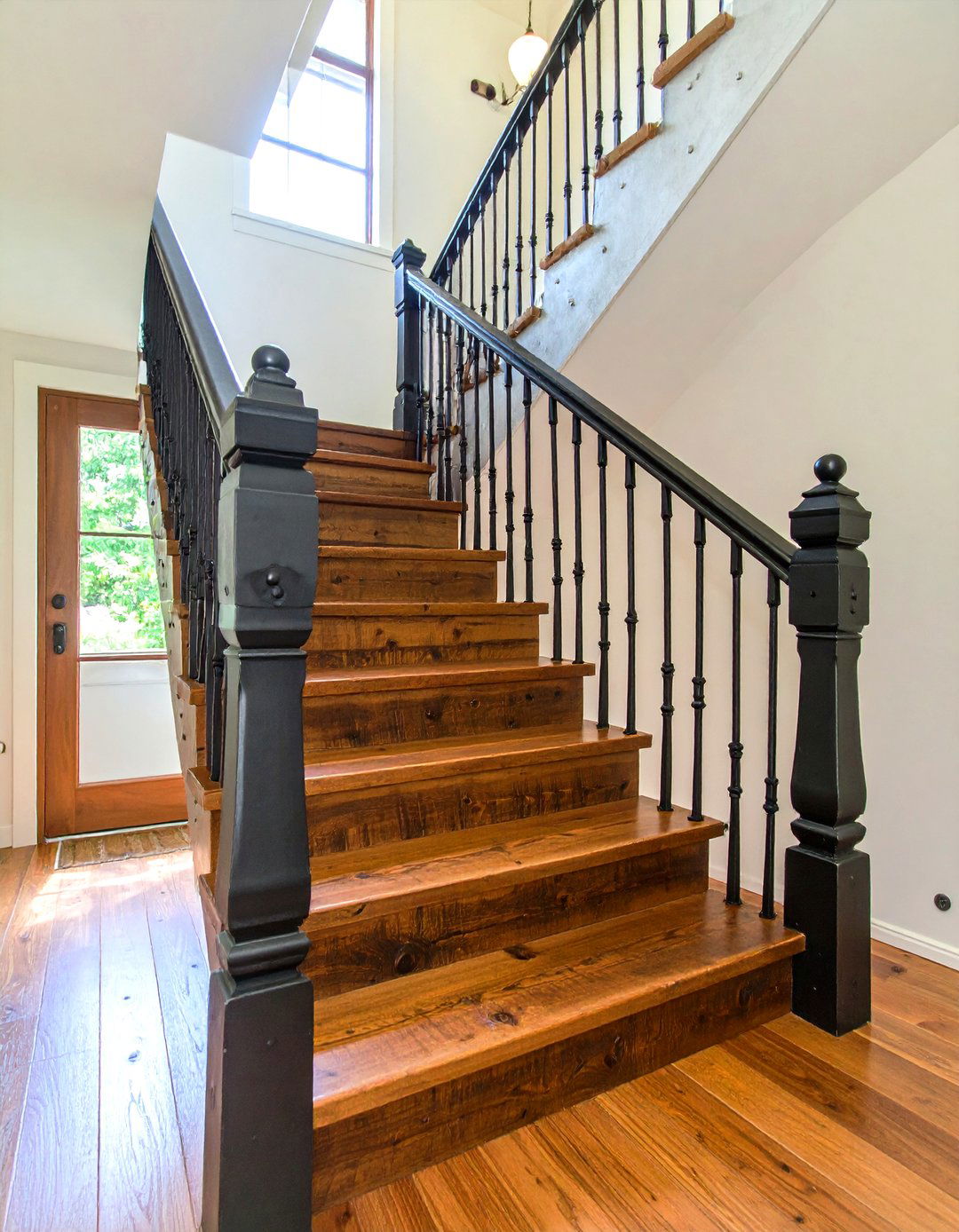
A reclaimed barn beam paired with slender black iron balusters instantly delivers the storybook charm farmhouse fans crave in a stair railing. The Spruce highlights this wood-and-metal combination as one of the most timeless ways to temper rustic warmth with architectural polish. Unlike factory-new lumber, barnwood arrives with nail holes, saw marks, and a silvery patina that hides everyday scuffs, so you can skip babying the rail during muddy-boot season. For a weekend update, rip a straight edge on the beam, sand lightly, then seal with matte poly before dropping it onto pre-drilled iron posts — no complicated joinery required. Search “reclaimed timber railing” on Houzz for plenty of bracket-spacing examples.
2. X-Pattern Wrought-Iron Stair Railing
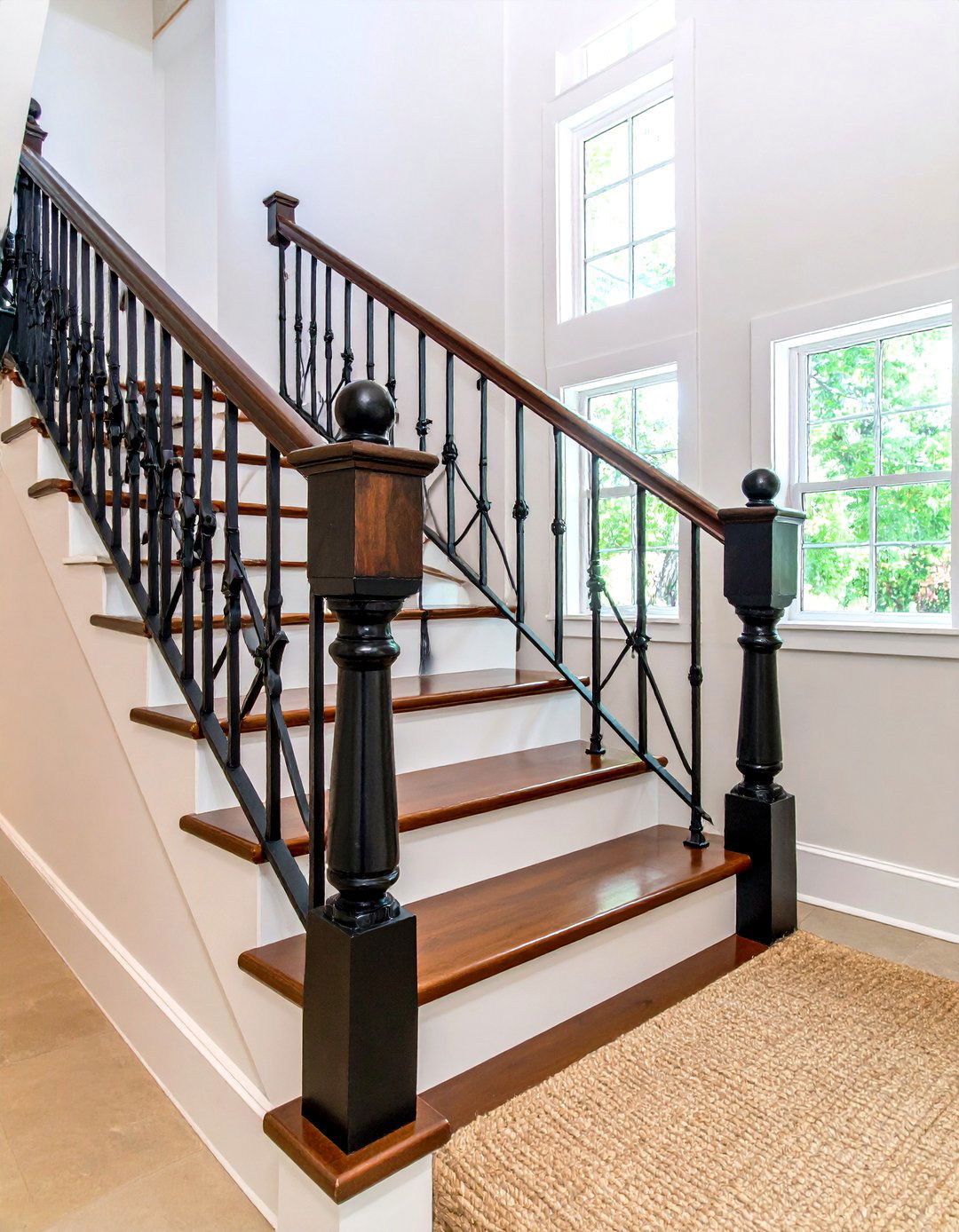
Unlike the predictable vertical picket, an X-pattern wrought-iron stair railing echoes cross-buck barn doors for instant farmhouse heritage. The Spruce says black criss-cross balusters read “modern rustic” while still meeting the 4-inch sphere safety code. Houzz designers add that the diagonal motif draws eyes upward, making tight stairwells feel taller. Prefabricated panels arrive welded and ready to lag-bolt into place — an approachable DIY for anyone handy with a drill and level. Top the iron with a chunky stained-oak cap so hands won’t feel chilly in winter.
3. Cable Rail & Weathered-Timber Stair Railing
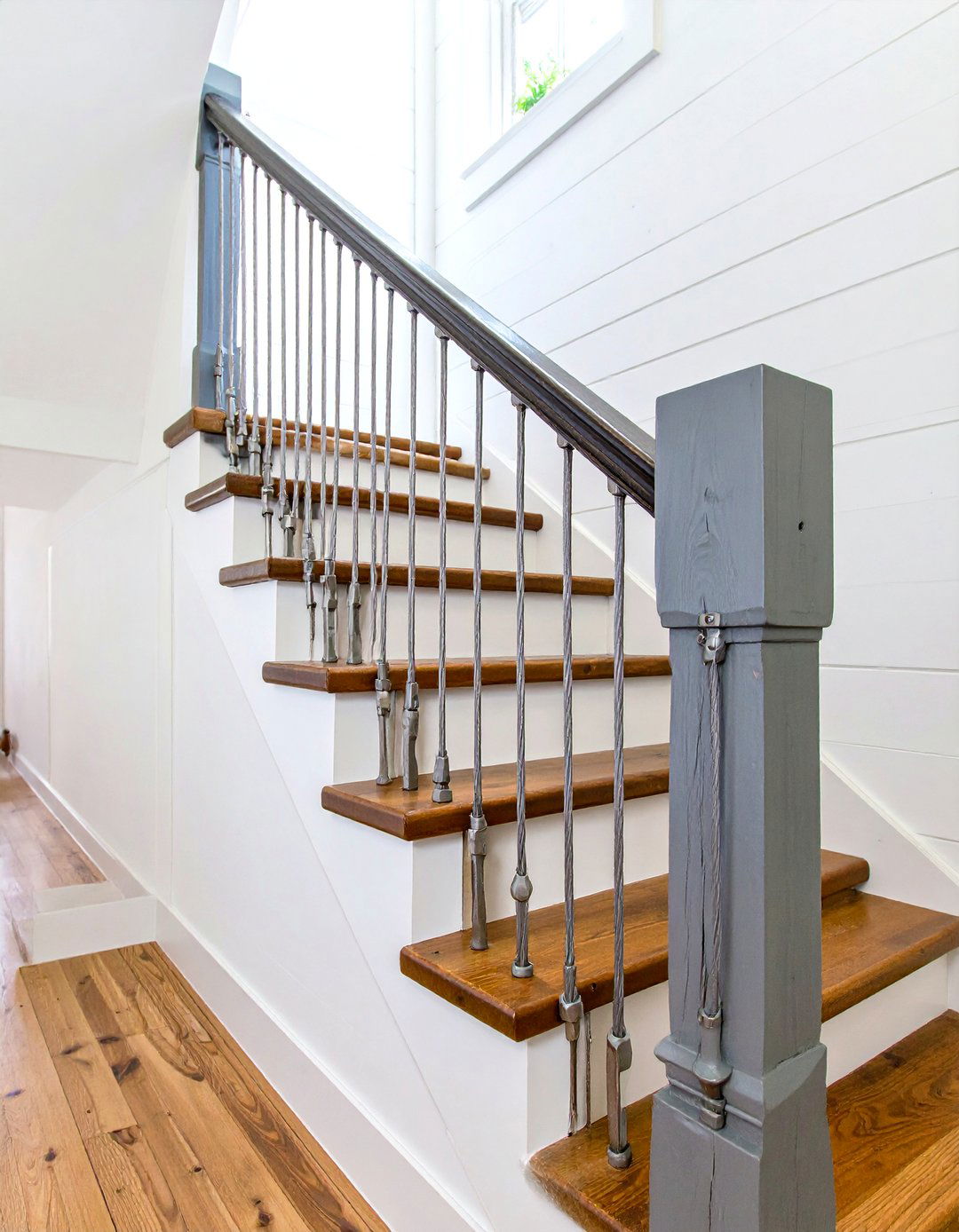
To keep sightlines open, swap spindles for marine-grade stainless cable threaded through weathered-timber posts. Houzz photo tours prove cable almost disappears, letting knotty pine treads and white shiplap walls shine. The Spruce notes that horizontal lines feel contemporary yet still rustic when framed by rough-sawn posts. Pretension hardware kits make installation simple: drill, insert sleeve, tighten, and trim excess. Use a scrap 4-inch block as a spacer to meet code, and seal the posts with clear matte finish to lock in their gray patina.
4. Industrial Black-Pipe Stair Railing
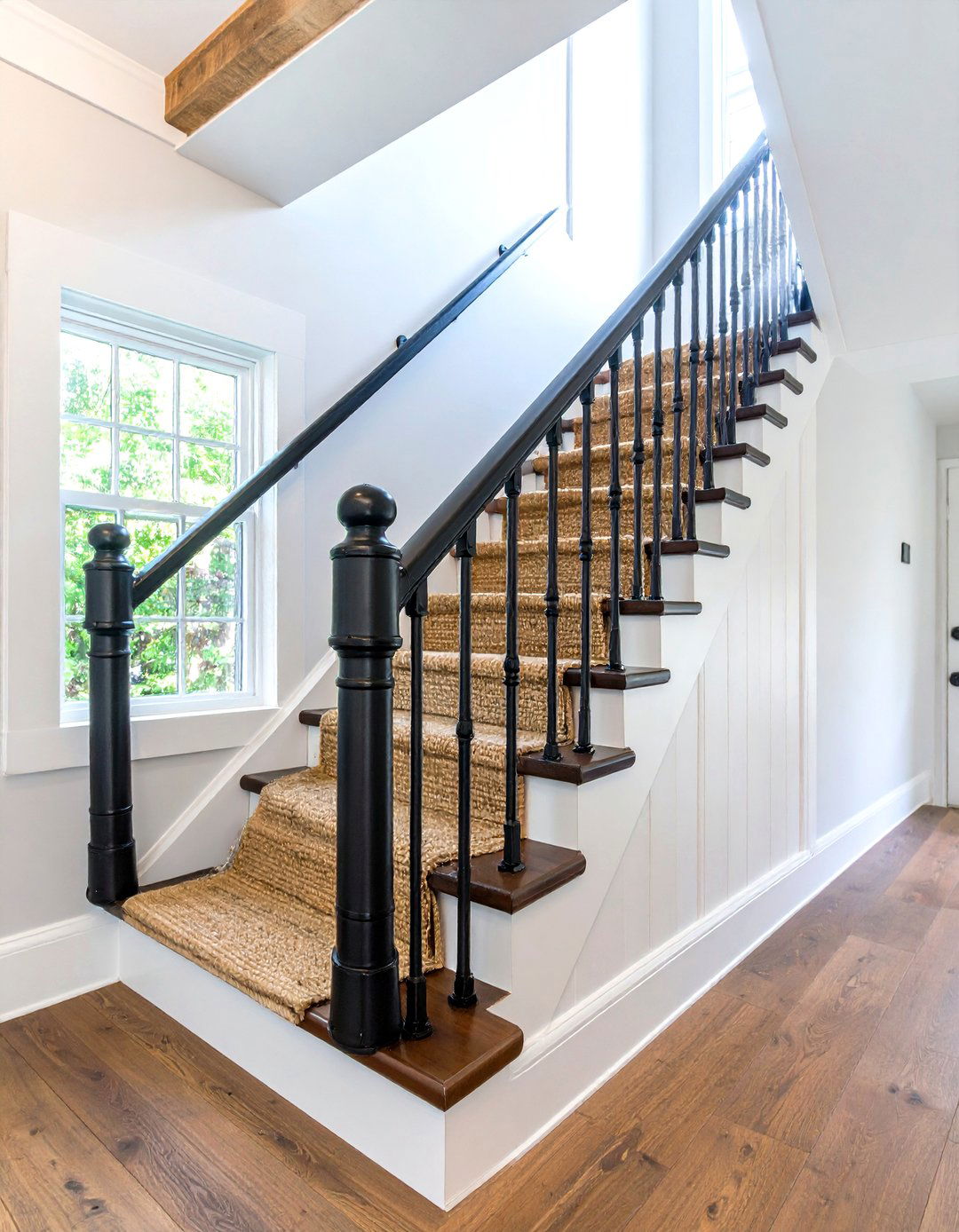
Trade polished wood for 1-¼-inch black steel pipe and flanges to give your stair railing a factory-floor twist. BHG lists exposed piping as a quick route to character without heavy carpentry. Amazon sells pre-threaded kits with elbows, floor flanges, and mounting screws — just locate studs and twist pieces together. For balance, offset the dark metal with white risers and a jute runner. A matte clear coat stops oily residue, and threaded plugs cap sharp ends so sleeves won’t snag.
5. Rope-Banister Stair Railing
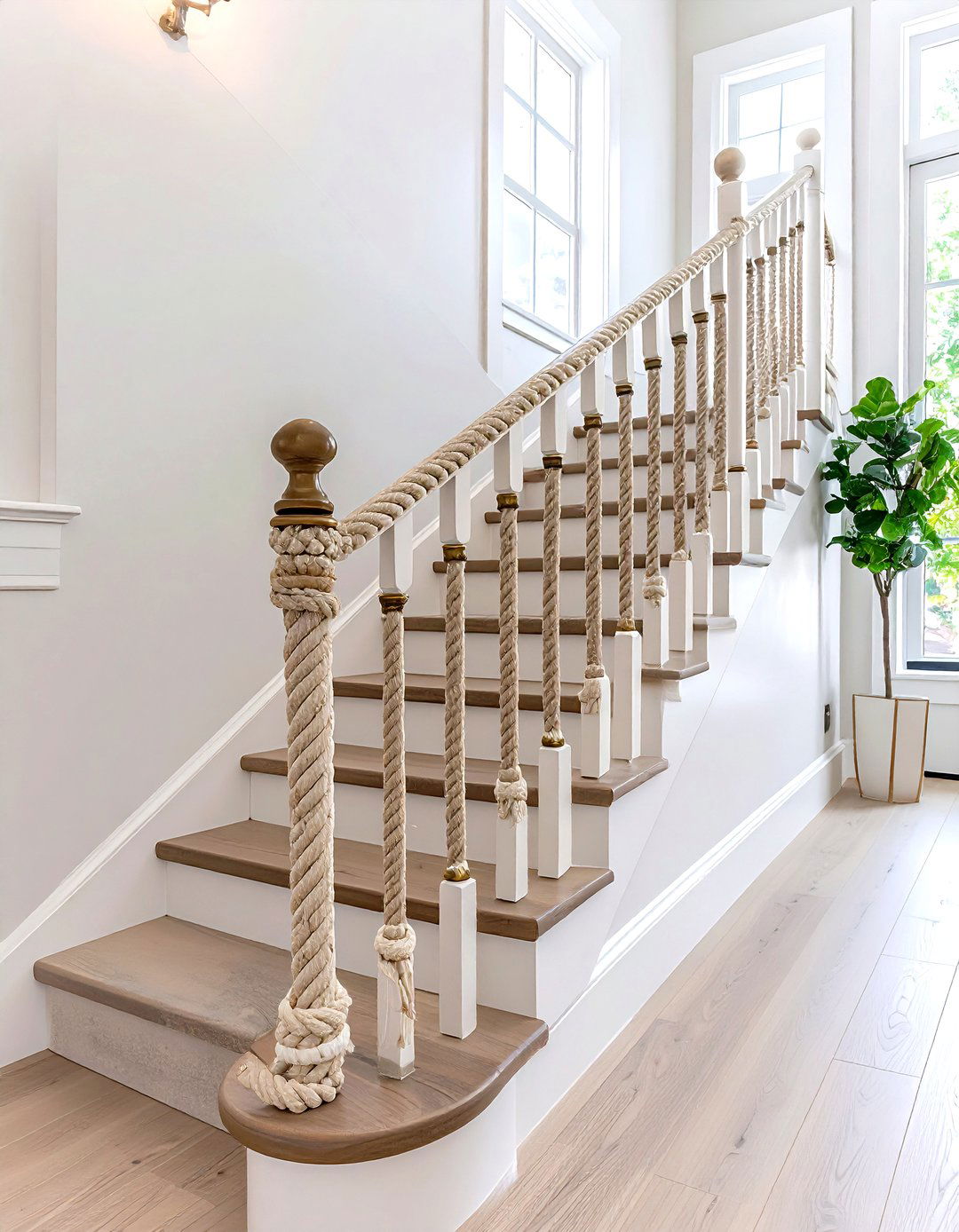
Surprisingly, a thick cotton rope can turn a plain stair railing into breezy coastal-farmhouse sculpture. Architectural Digest profiled designer Daniel Romualdez’s Ibiza villa, where a sub-$100 rope banister feels custom thanks to sailor’s knots at each bracket. Pinterest boards replicate the idea with sisal and manila rope secured by brass cleats or iron brackets. Tape rope ends before cutting to prevent fray, pre-drill bracket holes into studs, and spritz the finished rope with fabric protector so muddy paws wipe off easily.
6. Shiplap-Backed Stair Railing Wall
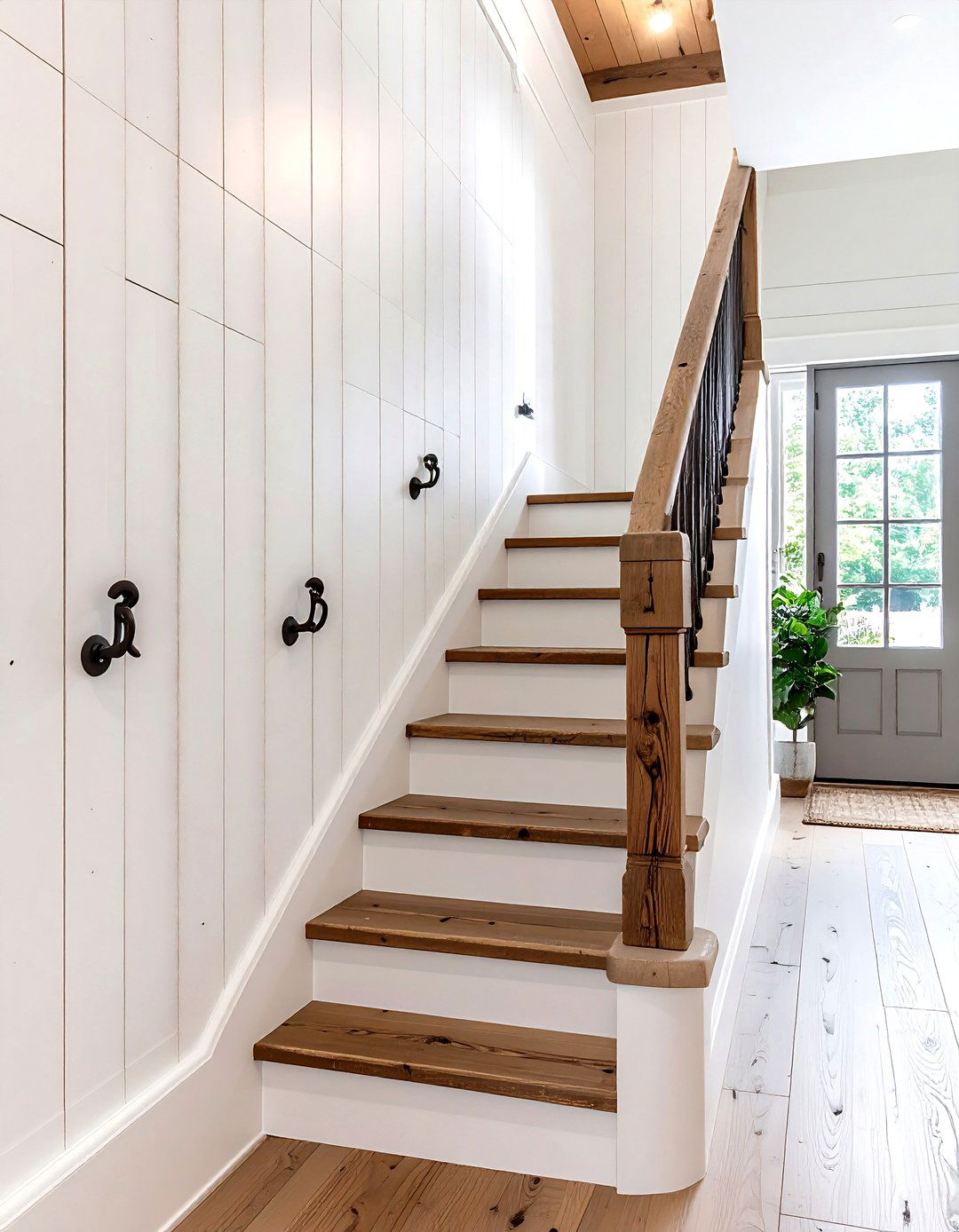
Nothing says farmhouse like crisp shiplap, so clad the guard-wall beneath your stair railing with painted boards. Southern Living showcases foyers where vertical shiplap brightens narrow stairwells and frames weathered-oak handrails. The Spruce recommends anchoring the look with a half-newel post that hides board edges. Space boards with a nickel gap, finish in scrub-able satin white, and add wrought-iron hooks between planks for grab-and-go tote storage.
7. Branch-Baluster Stair Railing
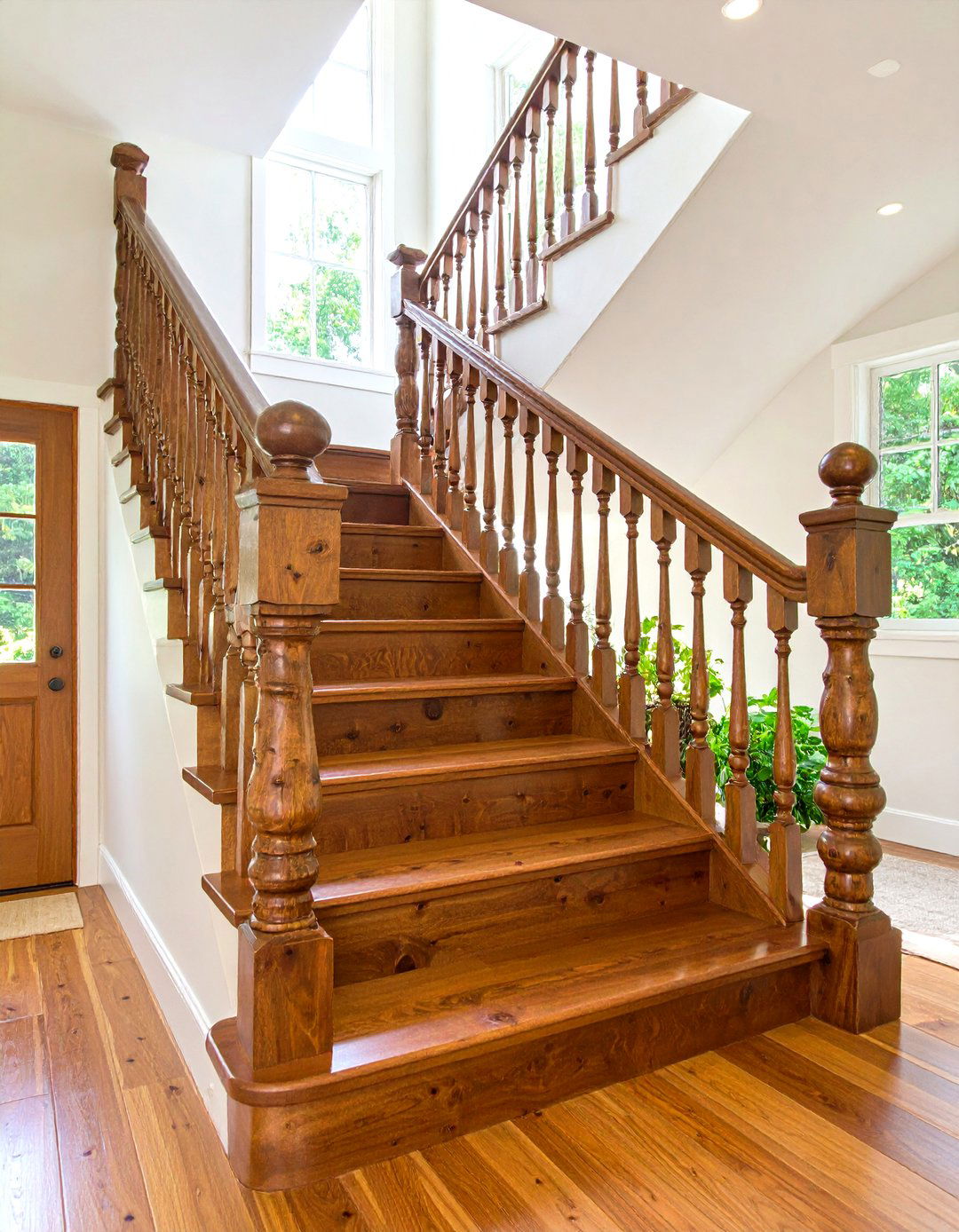
Harvest thumb-thick maple branches and peel the bark to create an organic stair railing lifted from a forest cottage. A YouTube tutorial shows mortising each crooked branch into routed grooves for a code-approved yet untamed look. Pinterest collections mix birch, cedar, and aspen to vary color and texture. Dry branches indoors for two weeks to prevent shrinkage gaps, then seal with clear spar urethane so knots stay visible but wipe clean.
8. Chicken-Wire Panel Stair Railing
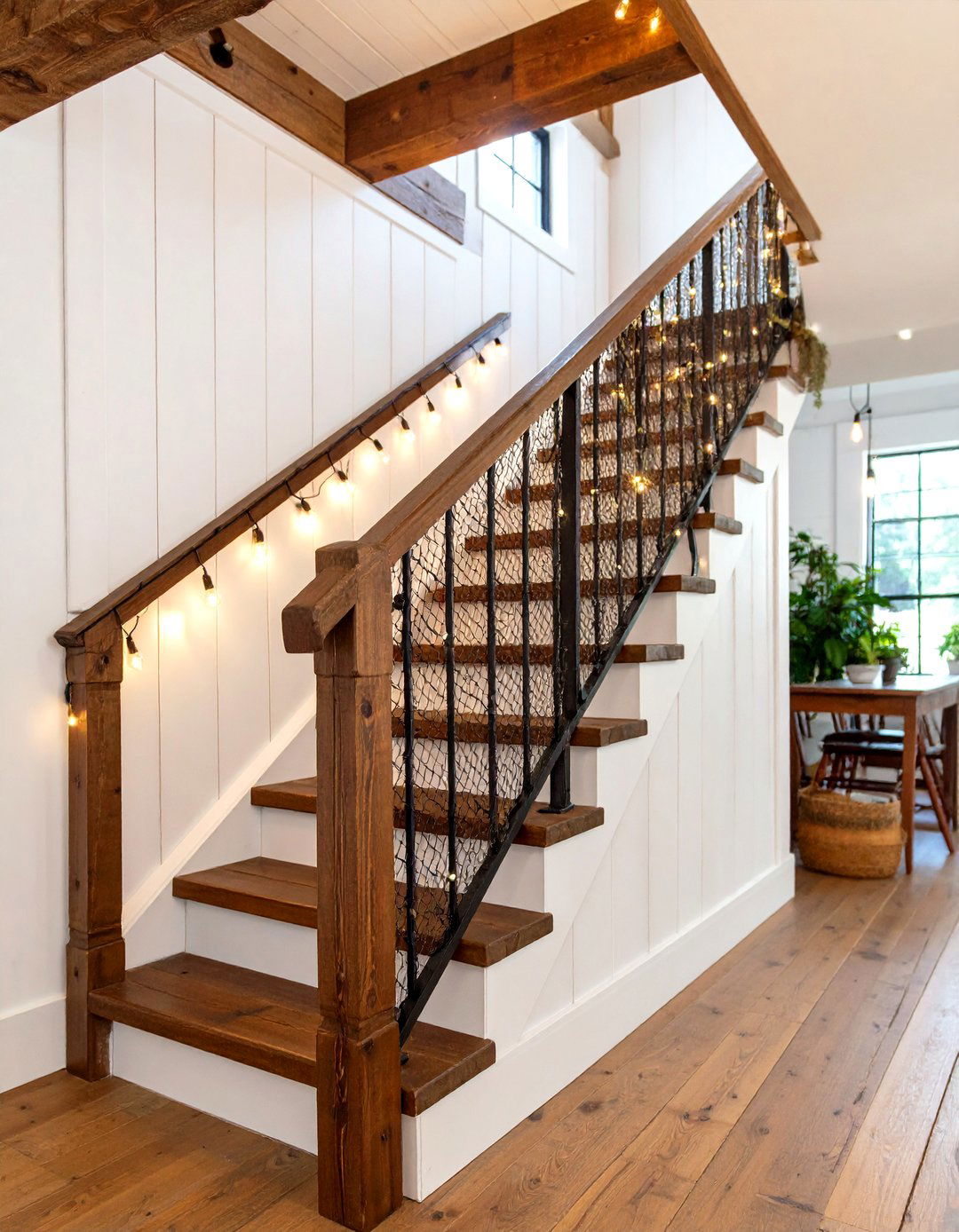
For barnyard charm on a budget, staple chicken wire between rough-sawn frames to replace traditional spindles. The Spruce notes that mesh panels keep tight foyers open and airy. Pinterest DIYers stain frames dark walnut and tuck fairy-lights behind the wire for evening warmth. Use sturdy galvanized hardware cloth so kids can’t dent it, and pre-paint the lumber before stapling to avoid drips clogging the mesh.
9. Antler-Handrail Stair Railing
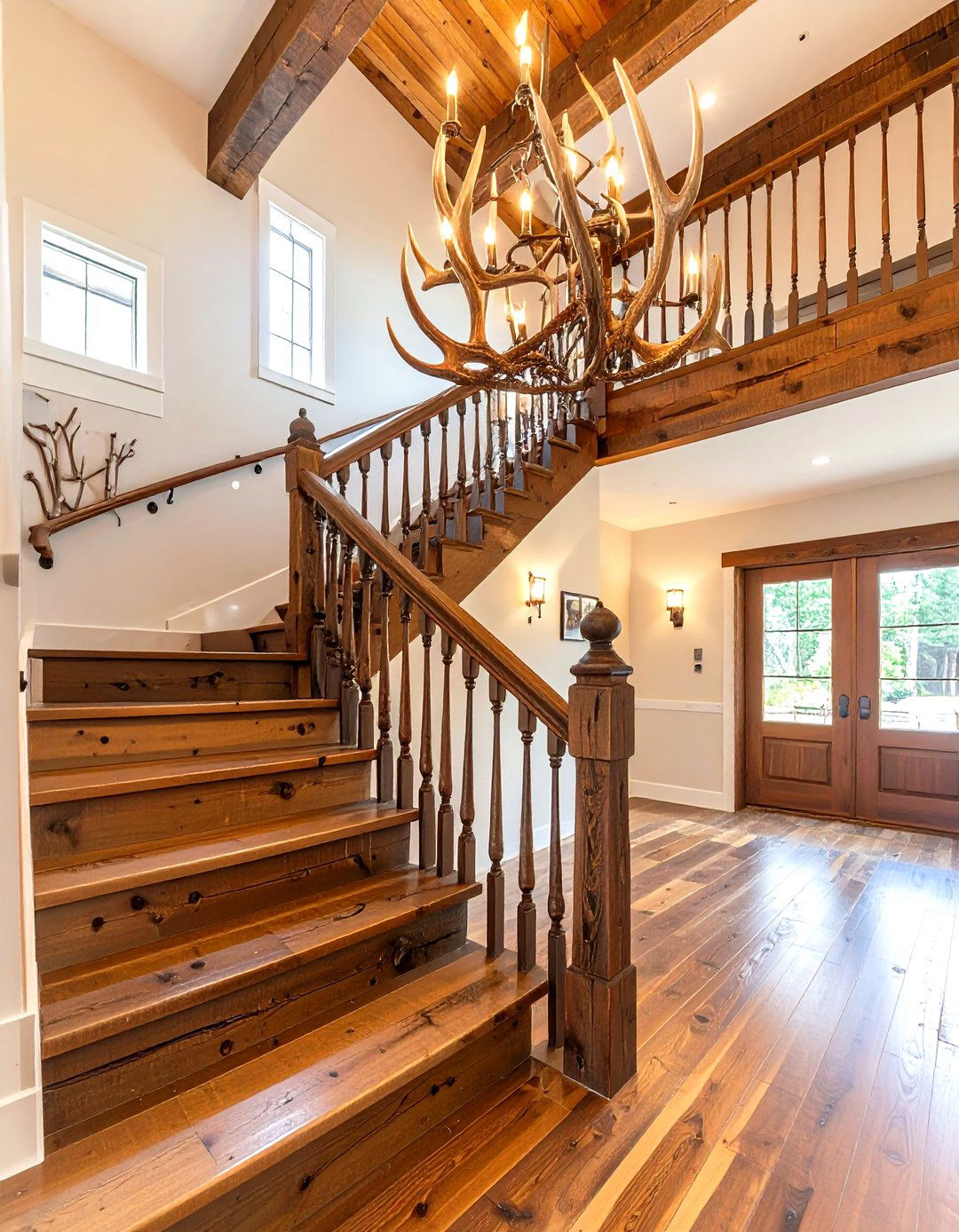
Mount naturally shed deer antlers in place of a conventional handrail for a stair railing that doubles as sculpture. Pinterest examples demonstrate how the organic curves fit comfortably in a palm while adding cabin flair. After cleaning and sealing, countersink screws through the antler bases into wall anchors. Sand sharp tips slightly and coat with matte polyurethane to protect sweaters and fingers alike.
10. Classic White-and-Oak Stair Railing
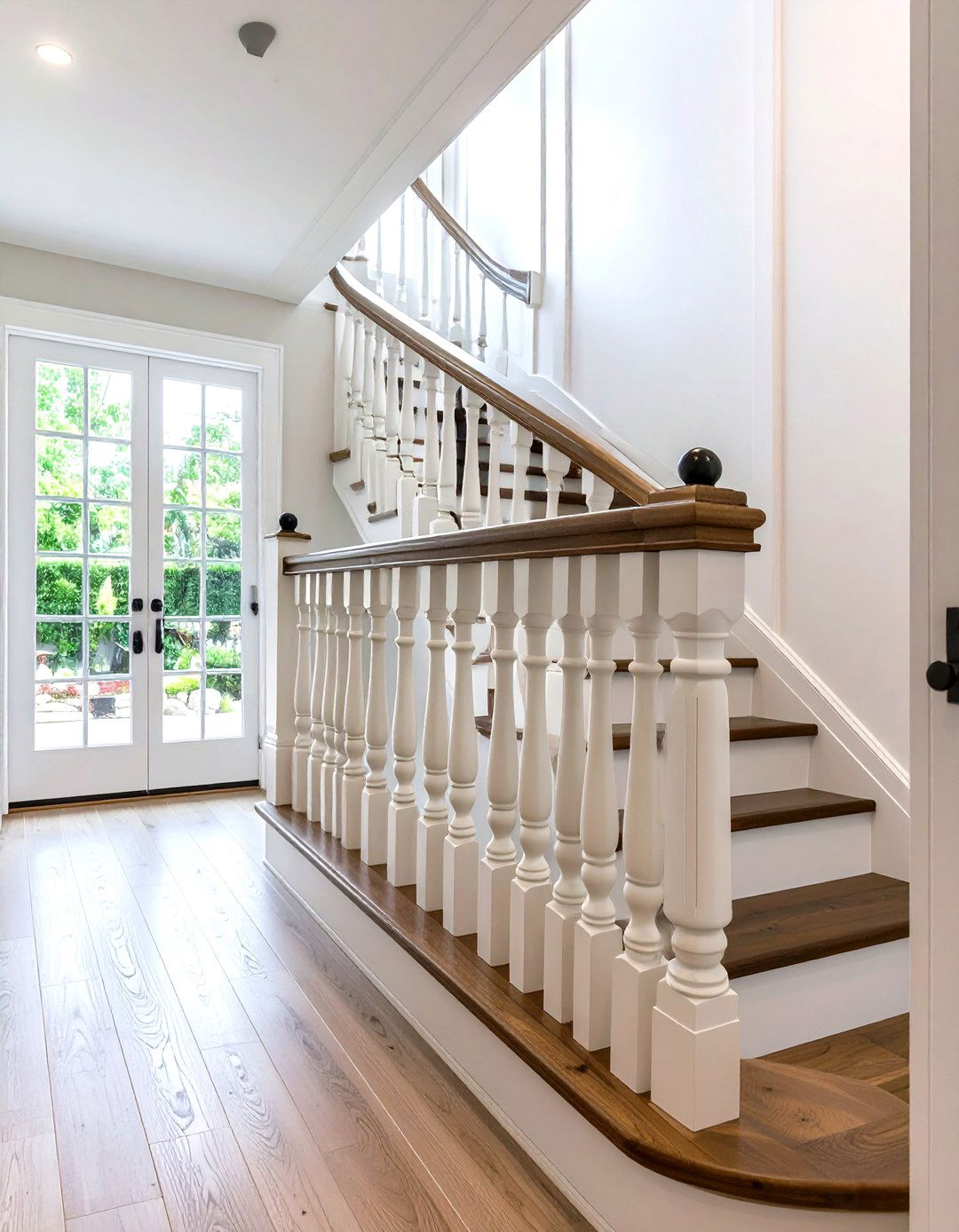
Painting balusters bright white and leaving the handrail natural oak delivers instant farmhouse refinement. The Spruce calls this palette the safest bridge between modern updates and 100-year-old millwork. Degrease, sand, and prime spindles before two coats of enamel. Lightly oil the rail so grain pops, and swap dated brass fittings for satin-black screws to anchor the high-contrast look.
11. Hog-Panel Grid Stair Railing
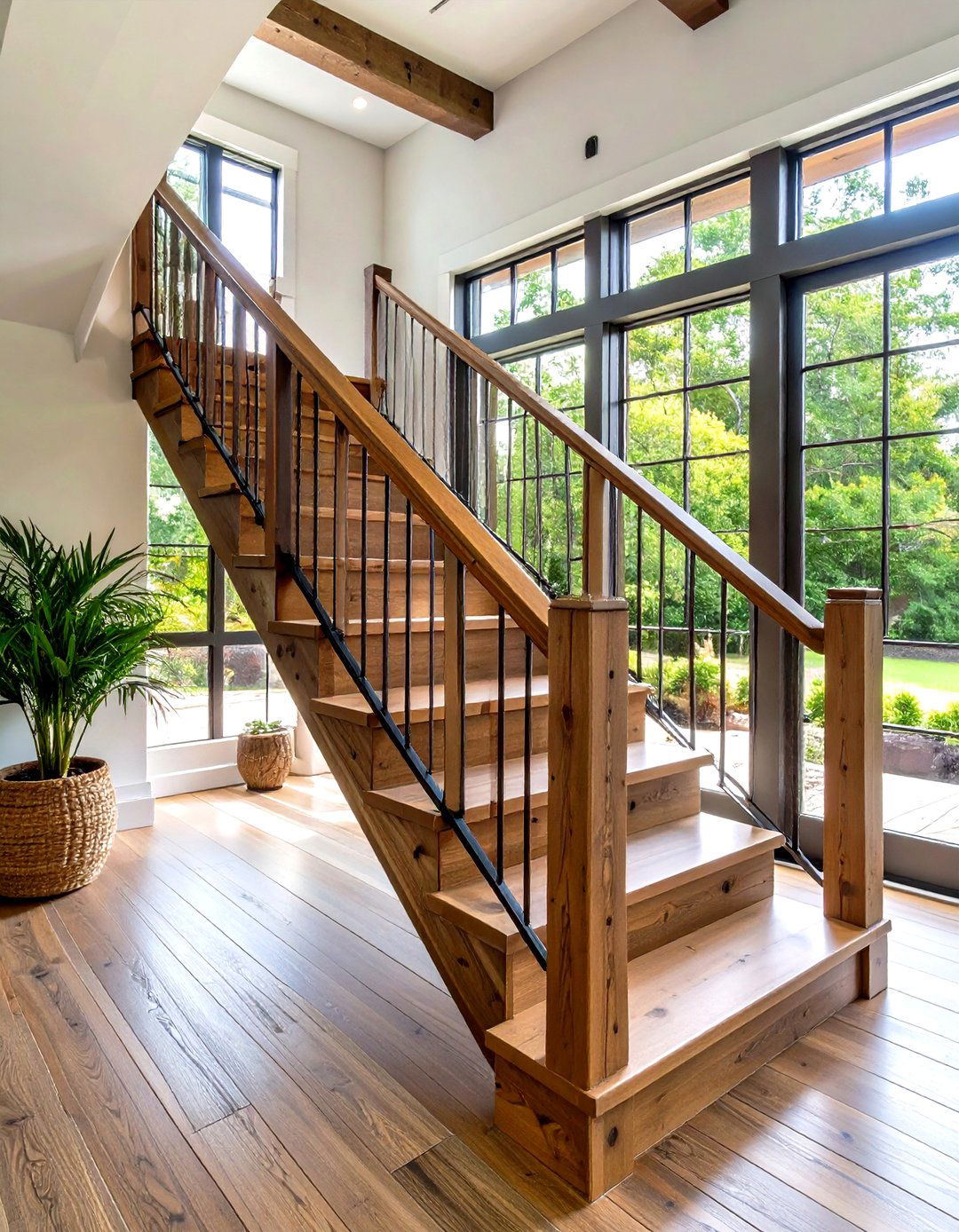
Leftover hog or cattle panels become an incredibly sturdy stair-railing insert when framed in pine. A YouTube build shows grinding edges smooth and screwing panels into routed grooves for a crisp industrial finish. Bob Vila reminds DIYers that guard height must hit 36 inches from tread nosing, so design your frame accordingly. Paint the mesh flat black or leave galvanized for authentic barn feel.
12. Galvanized-Pipe & Wood-Cap Stair Railing
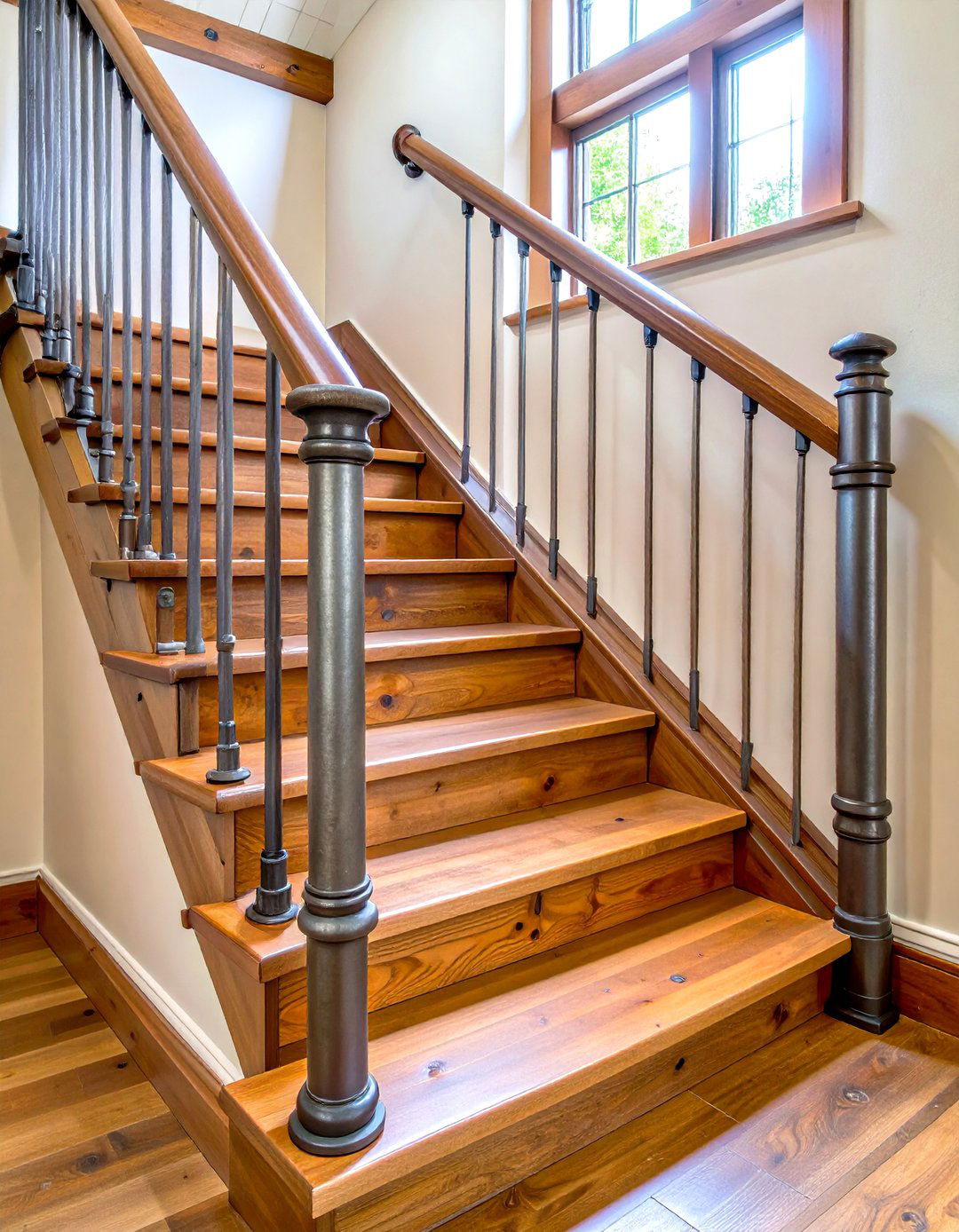
Galvanized pipe balusters capped with a simple oak board strike a perfect industrial-farmhouse balance. Houzz galleries highlight rugged conduit paired with warm wood for budget builds. Amazon pipe kits arrive pre-threaded, letting you screw flanges to the stringer and tighten verticals by hand. Age the metal with blackening wax, then scuff highlights back to silver for a well-traveled patina.
13. Vintage-Ladder Stair Railing
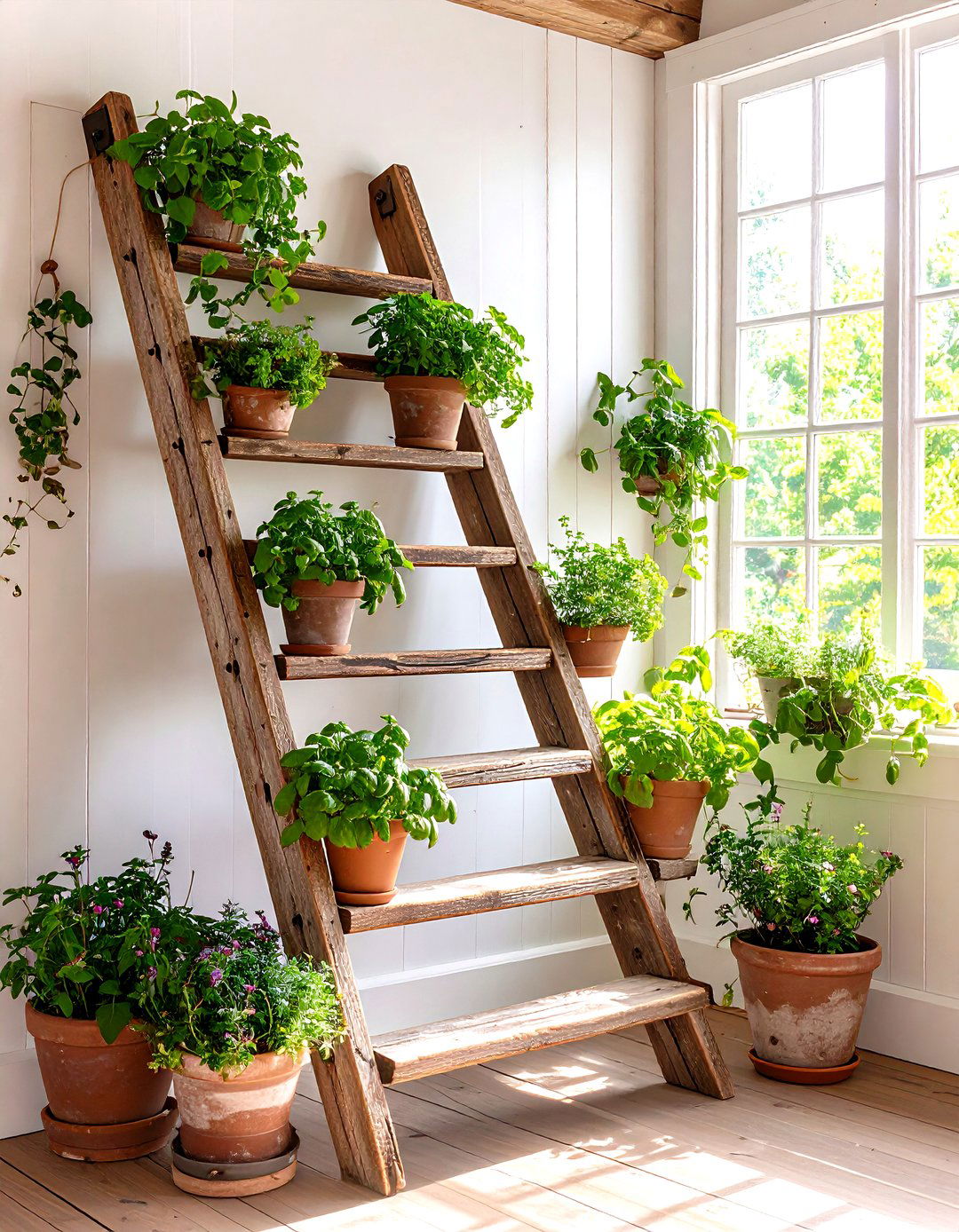
Flip a weathered orchard ladder horizontally and bolt it to the wall for a stair railing packed with history. Pinterest users love that the rungs double as display ledges for potted herbs and framed photos. Etsy fabricators sell brackets sized precisely for ladder rails, removing mounting guesswork. Plane splinters, reinforce joints with hidden screws, and seal with satin polyurethane so hands glide smoothly.
14. Barn-Door-Hardware Stair Railing
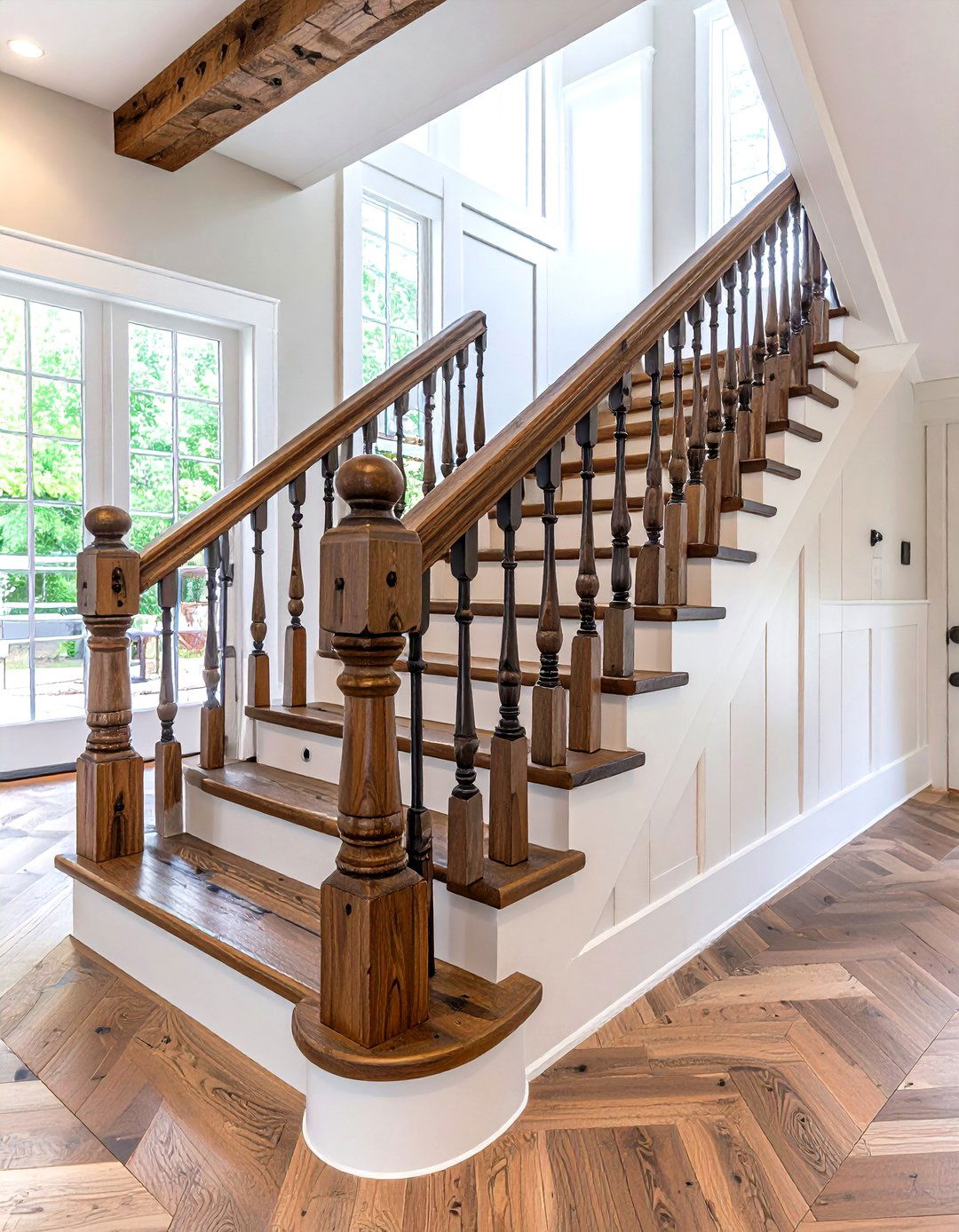
Use barn-door track hangers as oversize brackets for a chunky pine stair railing. Rustic Rolling Doors rates its powder-coated steel hardware for 300-pound doors, so you know your handrail is safe. Farmhouse Living tours often pair this hardware with white risers and herringbone runners for a refined, not rough, effect. Mount the rail slightly proud of the wall so the wheel detail stays visible and finish screws with acorn nuts for safety.
15. Rustic-Log Stair Railing
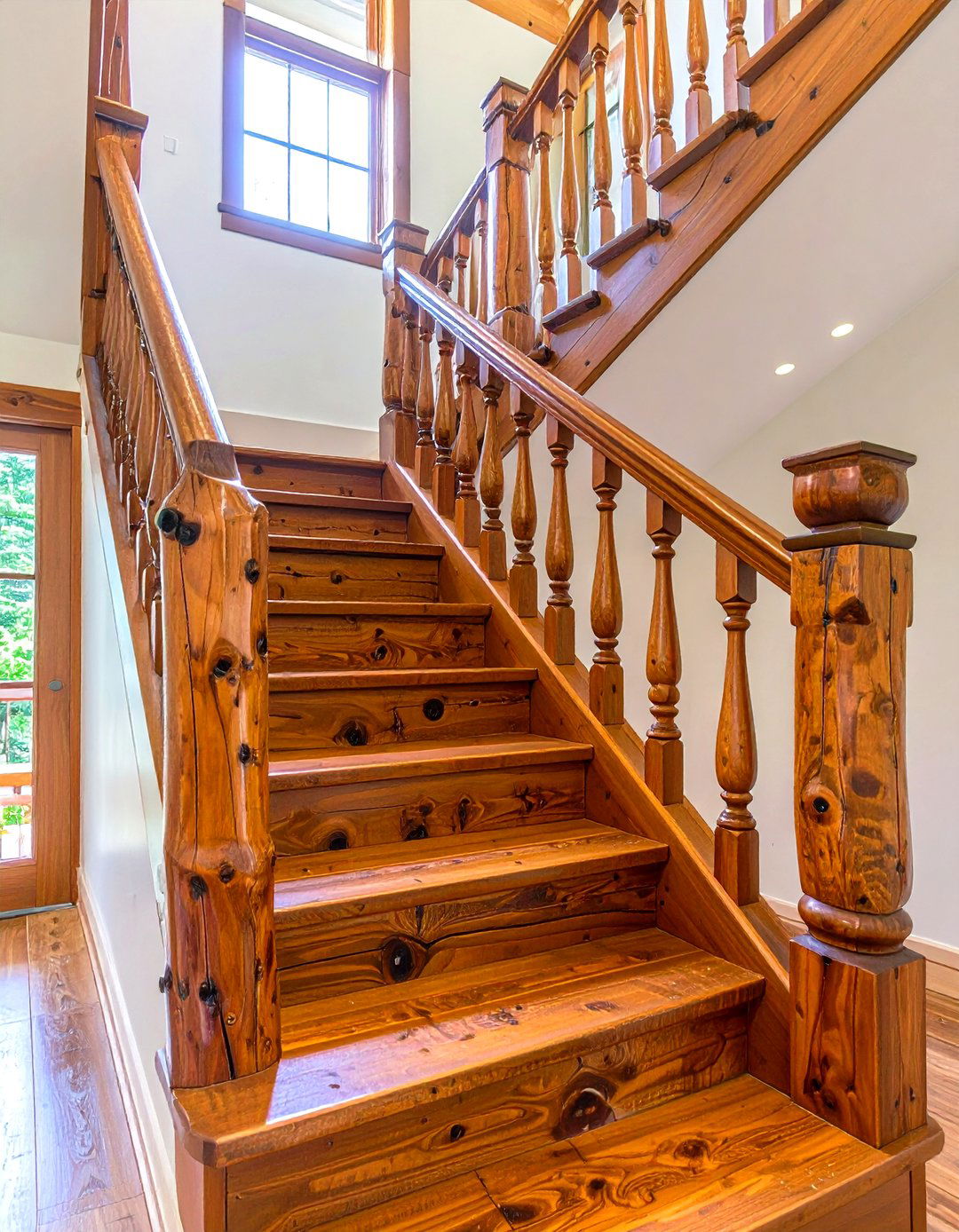
Kiln-dried peeled logs turn a staircase into a Smoky-Mountain retreat. Pinterest boards show log posts lightly chamfered to tame bulk. The Spruce recommends slim round-dowel balusters between hefty uprights to balance weight. Hide fasteners with lag screw connectors and finish with spar varnish to stop sap streaks.
16. Distressed Painted-Spindle Stair Railing
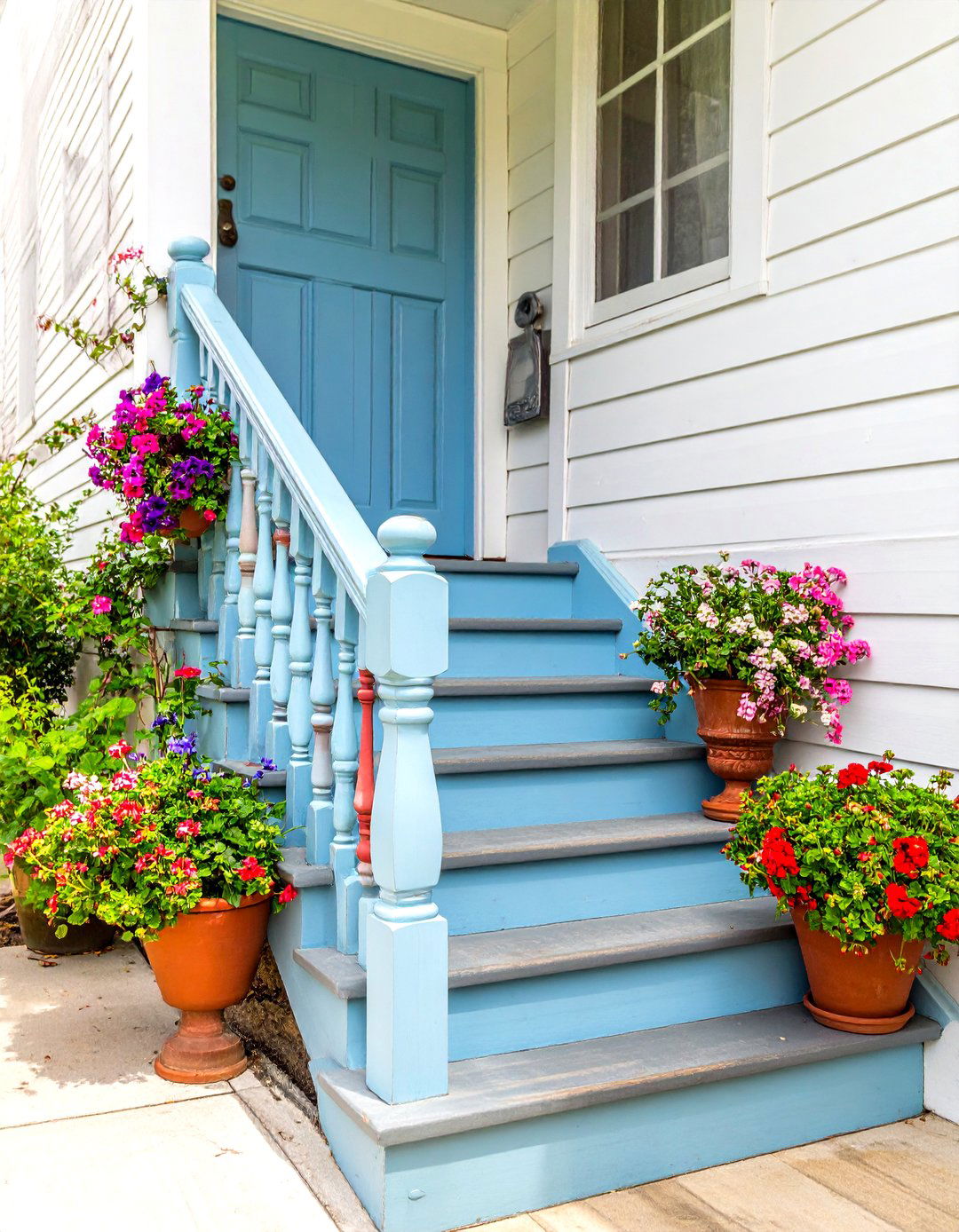
Revive mismatched thrift-store spindles with layered “chippy” paint for nostalgic charm. BHG features pastel-dipped balusters sanded back to reveal wood beneath. The Spruce advises repeating a single accent color — say barn-red — every few spindles to tie the rainbow together. Cap the eclectic lineup with a uniformly stained maple handrail for cohesion.
17. Mixed-Metal Modern-Farmhouse Stair Railing
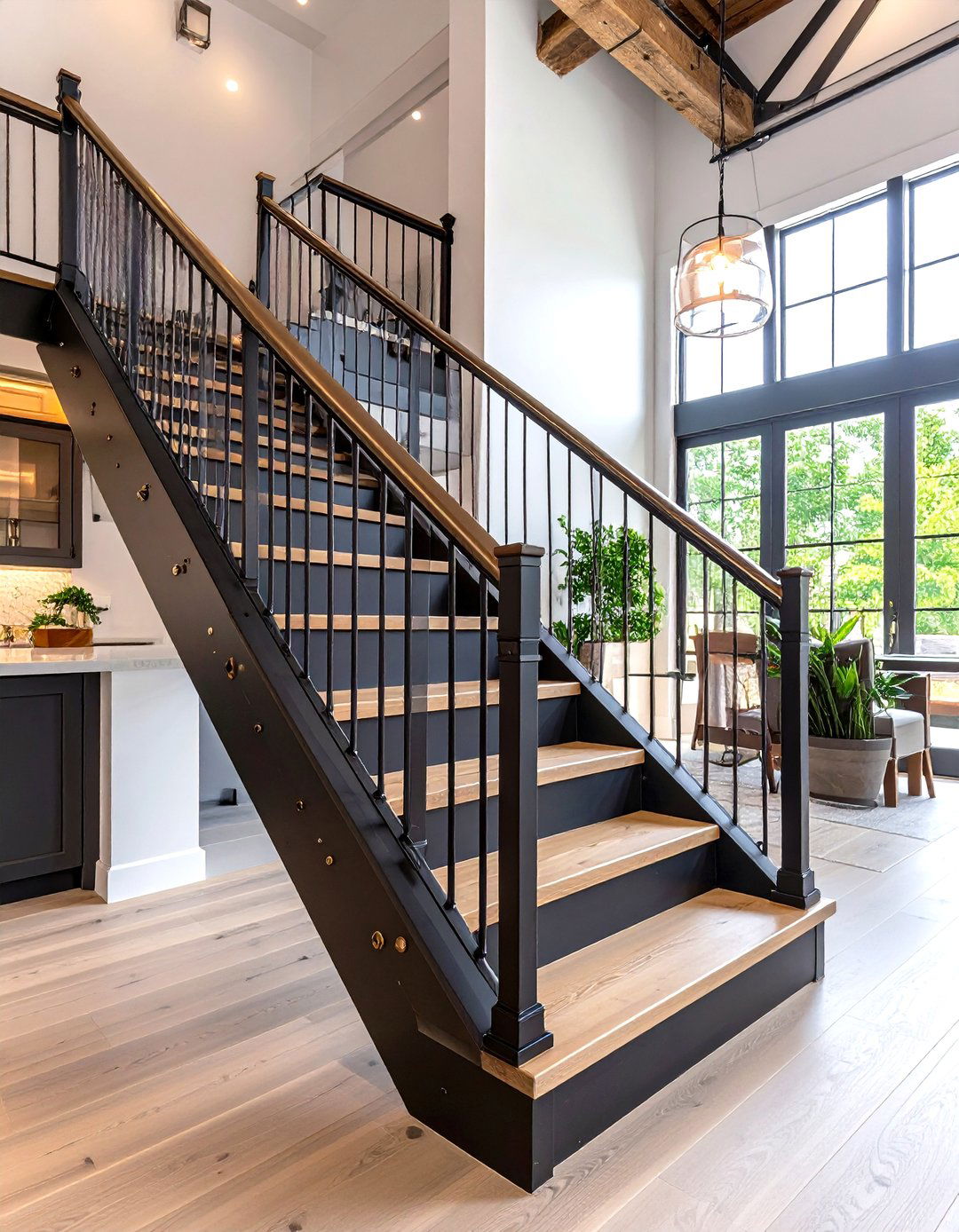
Layer black steel balusters, bronze brackets, and a brushed-nickel cap for a mixed-metal stair railing that reads modern yet rustic. Houzz designers stress repeating each metal elsewhere for a deliberate palette. BHG adds that satin, not glossy, finishes keep the effect subtle and farmhouse-friendly. Clean with microfiber cloths to protect varied coatings.
18. Glass-Panel & Beam Stair Railing
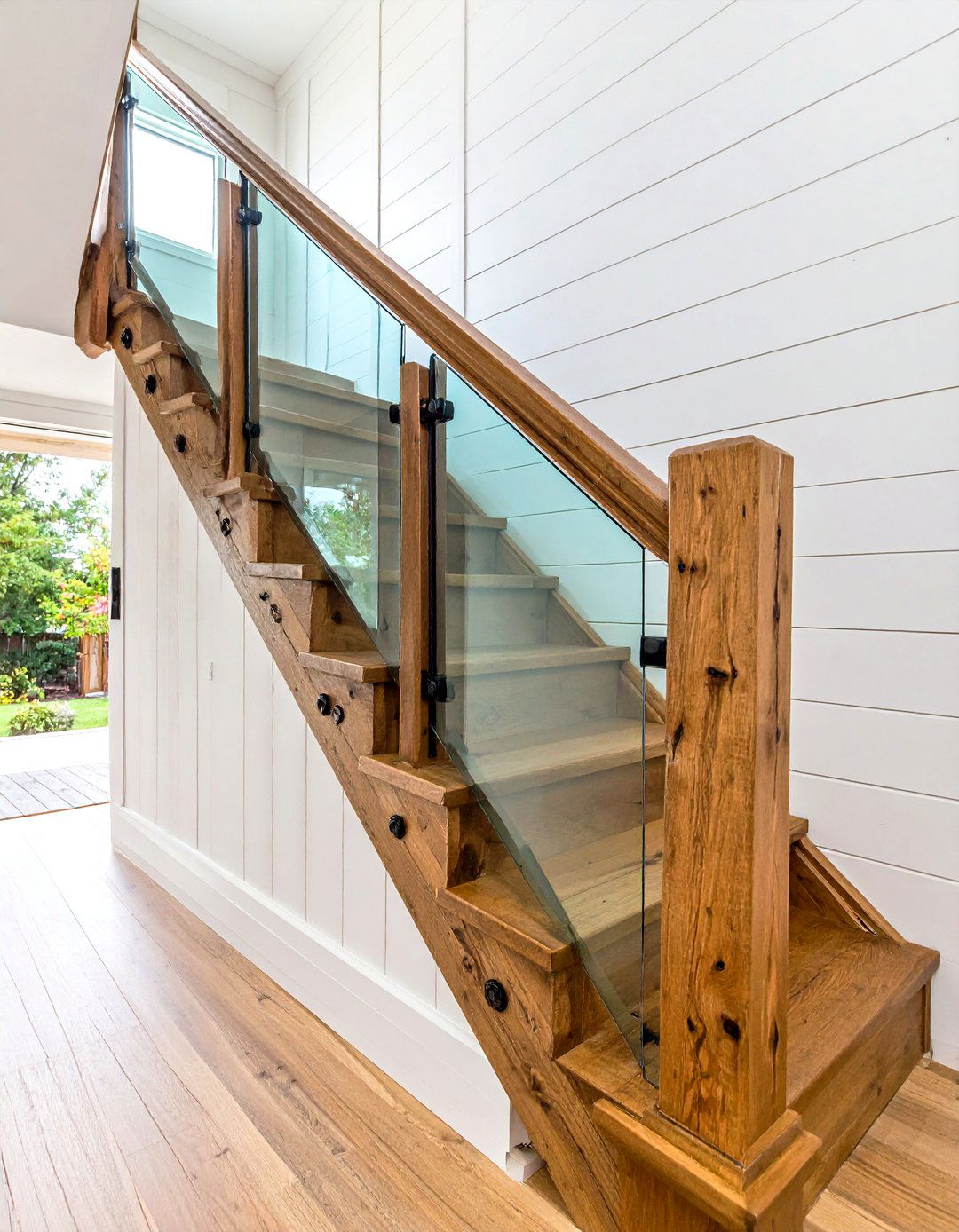
Pair clear tempered glass with a reclaimed-beam handrail to flood your staircase with light while honoring farmhouse DNA. BHG showcases transparent panels that let shiplap walls and knotty beams shine. The Spruce recommends stainless standoff brackets so glass floats slightly off the stringer. Seal the beam with furniture-grade oil so sunshine doesn’t create harsh glare.
19. Wire-Mesh Timber-Frame Stair Railing
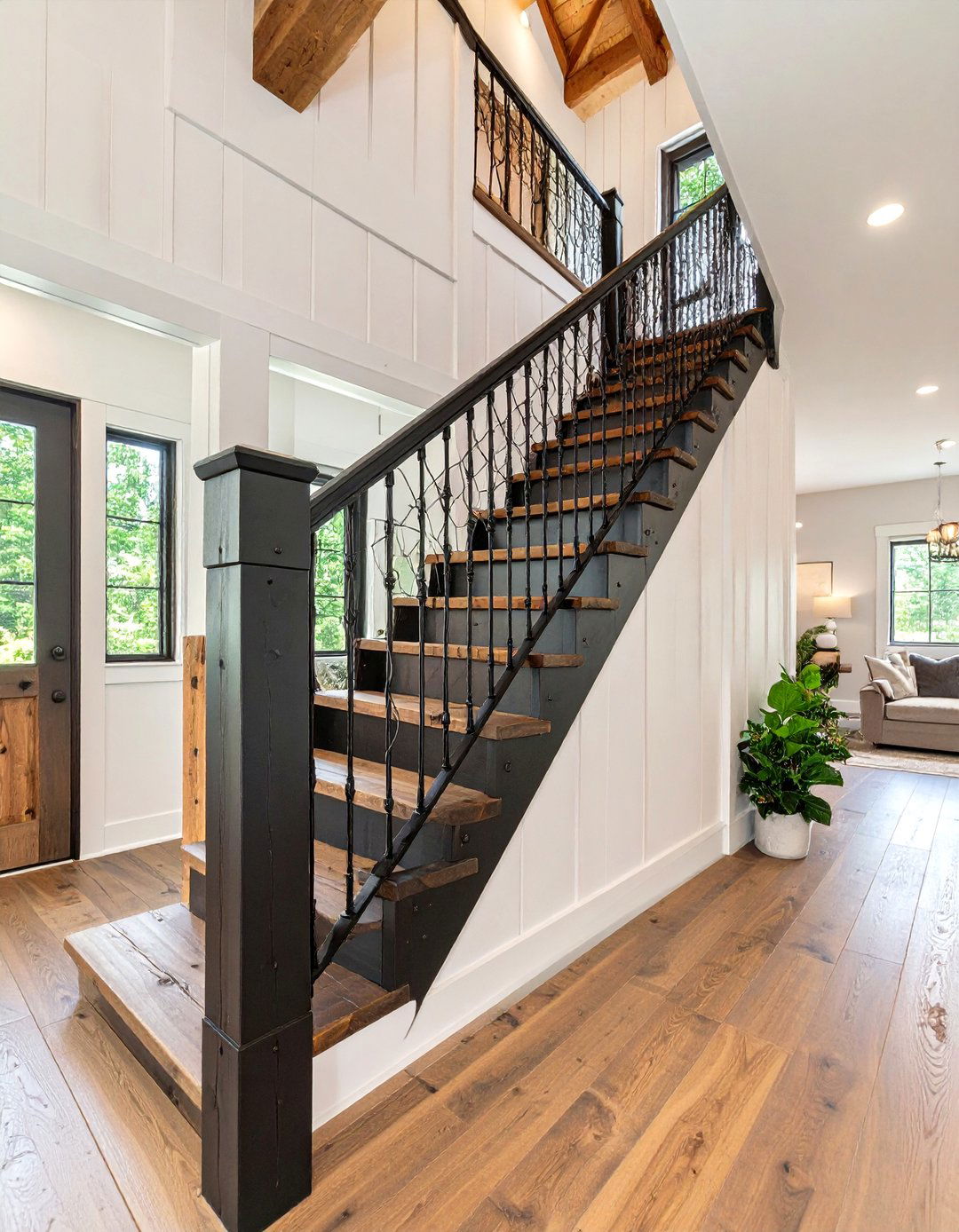
Timber-frame homes love wire-mesh infill under chunky posts for toddler-proof transparency. Bob Vila notes that open-rise stairs feel safer with a metal “net. ” The Spruce says square geometry contrasts nicely with hand-hewn beams. Clamp 4×4 welded mesh in dadoes, screw cover strips over edges, and touch up with flat-black paint.
20. Board-and-Batten Half-Wall Stair Railing
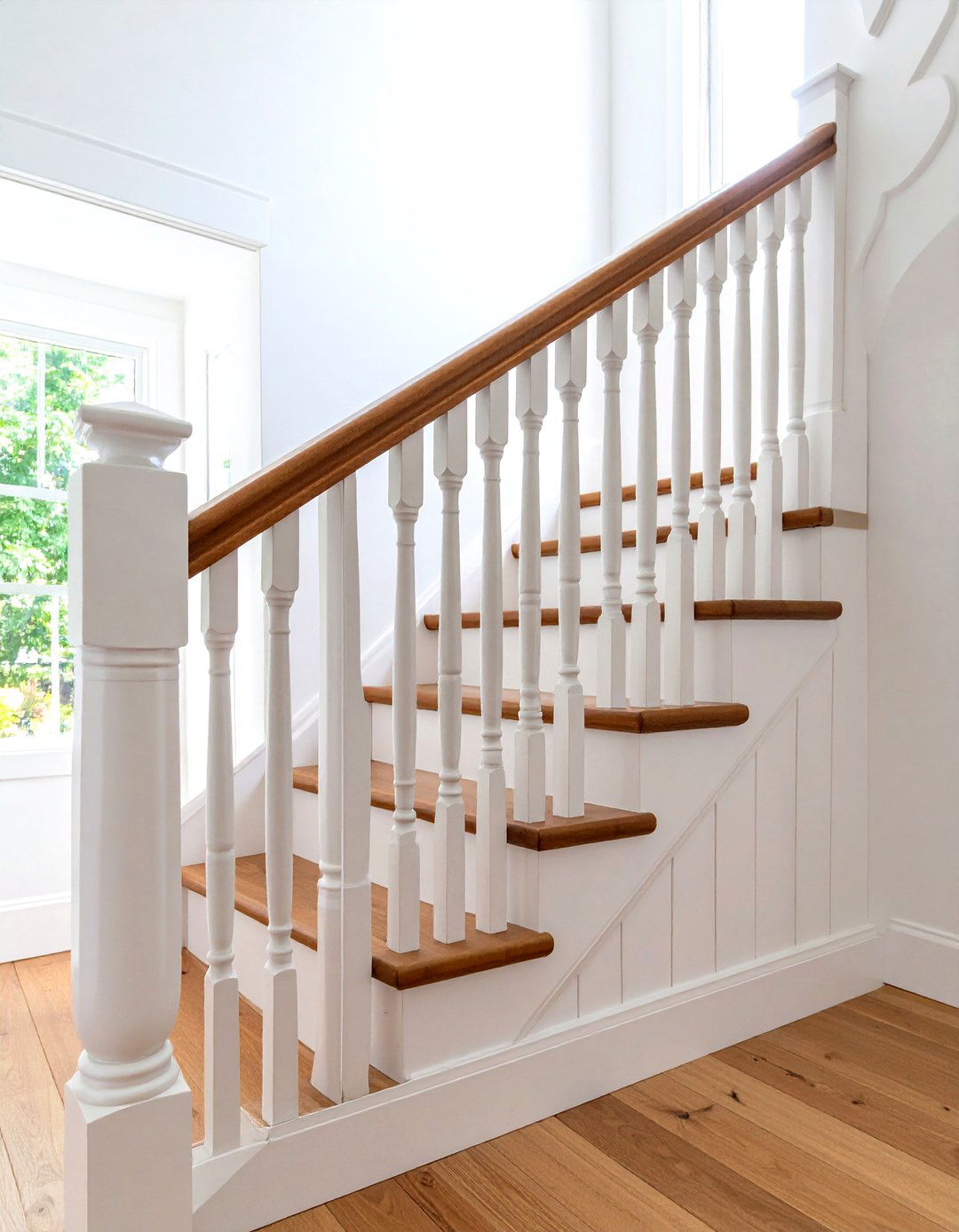
Build a 42-inch-tall board-and-batten guard topped with a beefy oak cap for a railing that doubles as an accent wall. Southern Living demonstrates how vertical battens hide scuffs and add rhythm. BHG suggests echoing the spacing on nearby doors so the treatment feels custom. Use moisture-resistant MDF, prime thoroughly, and caulk seams before painting.
21. Live-Edge Wood-Handrail Stair Railing
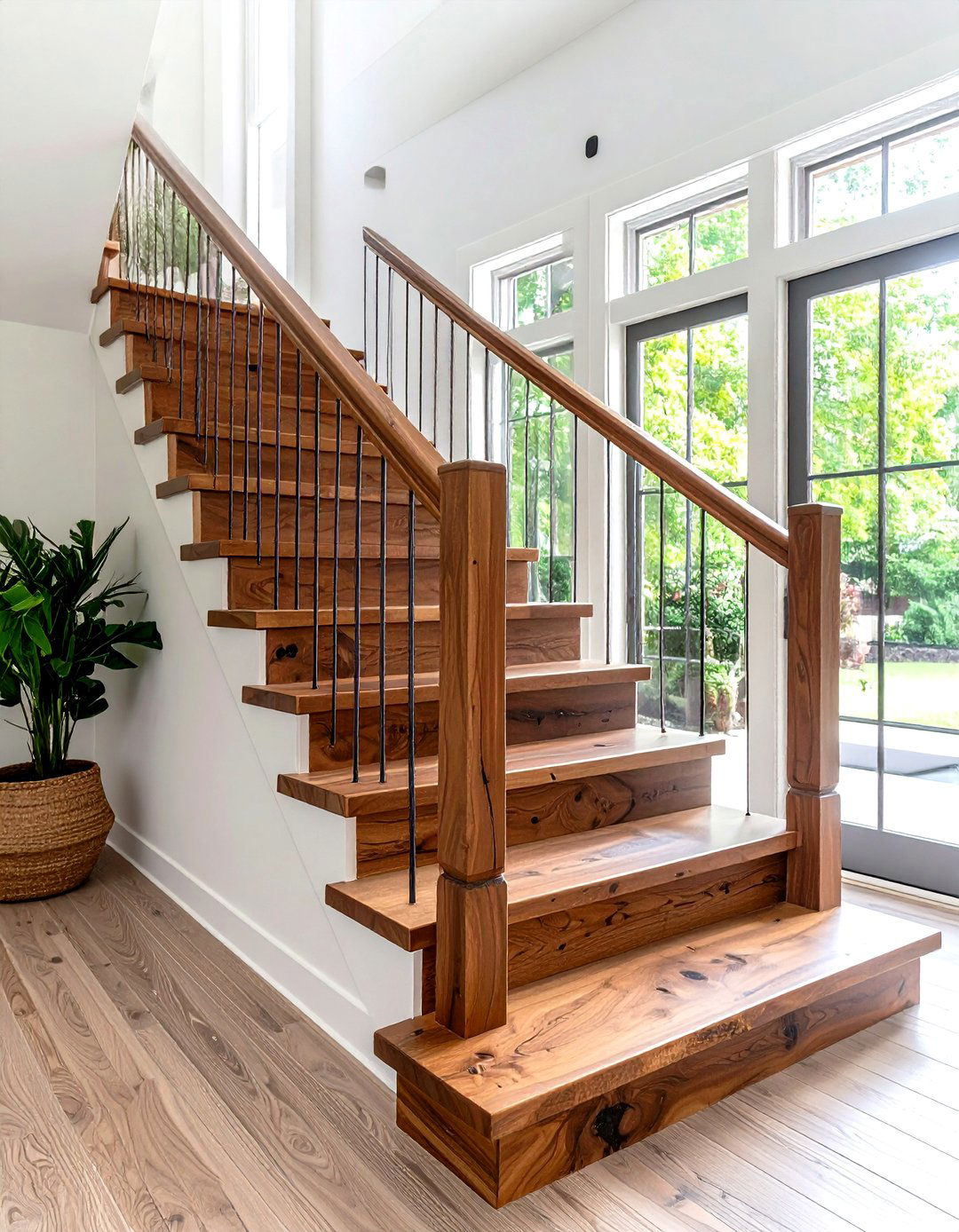
A live-edge slab turns every step into a nature walk. Pinterest galleries feature walnut rails whose bark-side edge faces outward for tactile interest. Bob Vila reminds builders to keep average rail height at least 34 inches, even where the edge dips. Rout a finger groove under the rail for better grip and finish with hard-wax oil.
22. Forged-Iron-Scroll Stair Railing
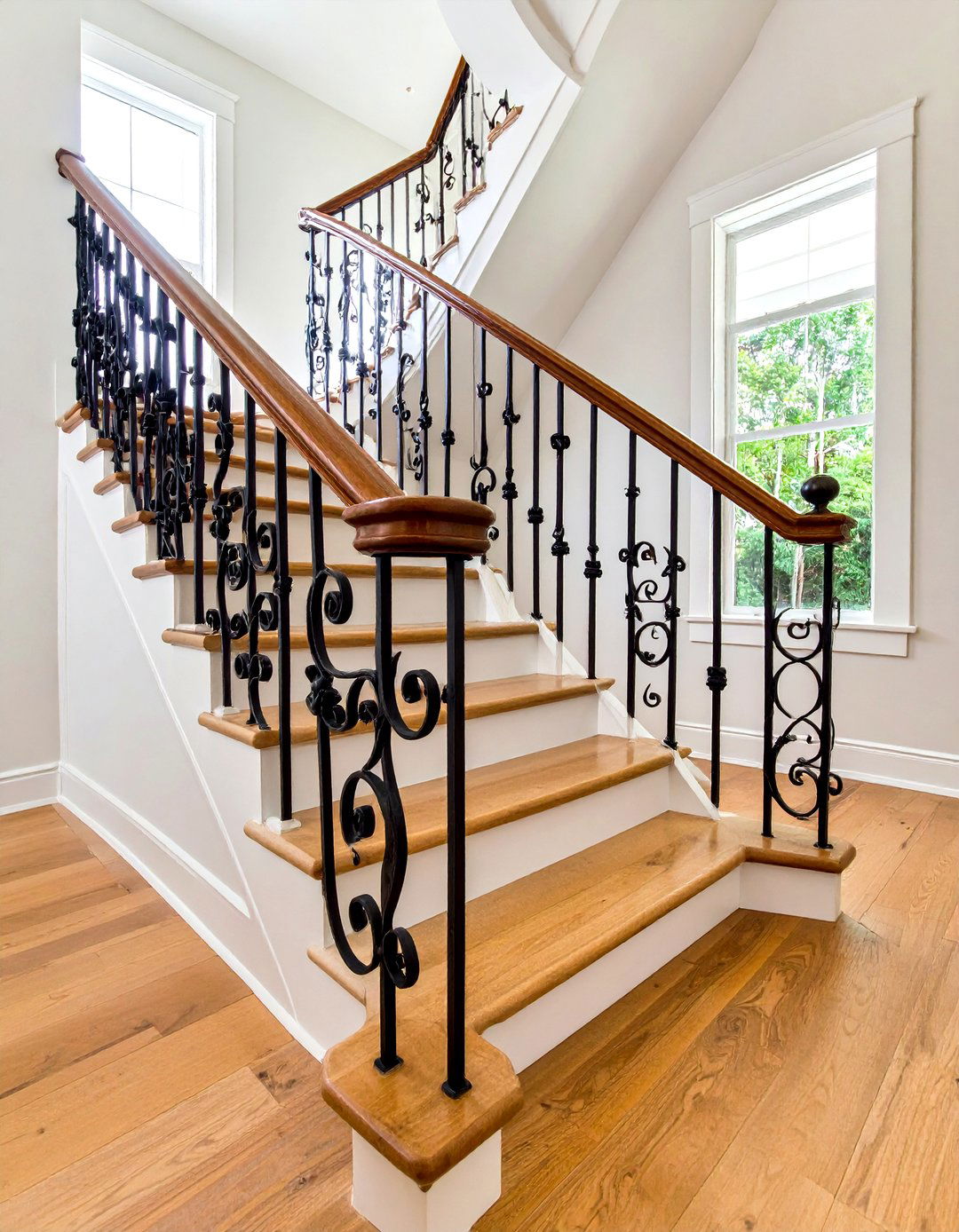
Nothing melds elegance and rustic appeal like forged-iron scrollwork topped with a chunky oak cap. BHG lists scroll balusters as an easy swap that boosts resale. The Spruce recommends a warm-stain cap so the wood complements ornate curls. Use a flat clear coat on the iron to mute reflections and let the silhouette shine.
23. Planter-Box Stair Railing

Integrate a slim cedar planter box between posts so greenery cascades over your stair railing. Houzz images show pothos softening cable rails while preserving sightlines. BHG says living plants also dampen echo in vaulted farmhouses. Line with pond liner, drill drainage, and set saucers inside so water never drips onto treads.
24. Two-Tone Black-and-White Stair Railing
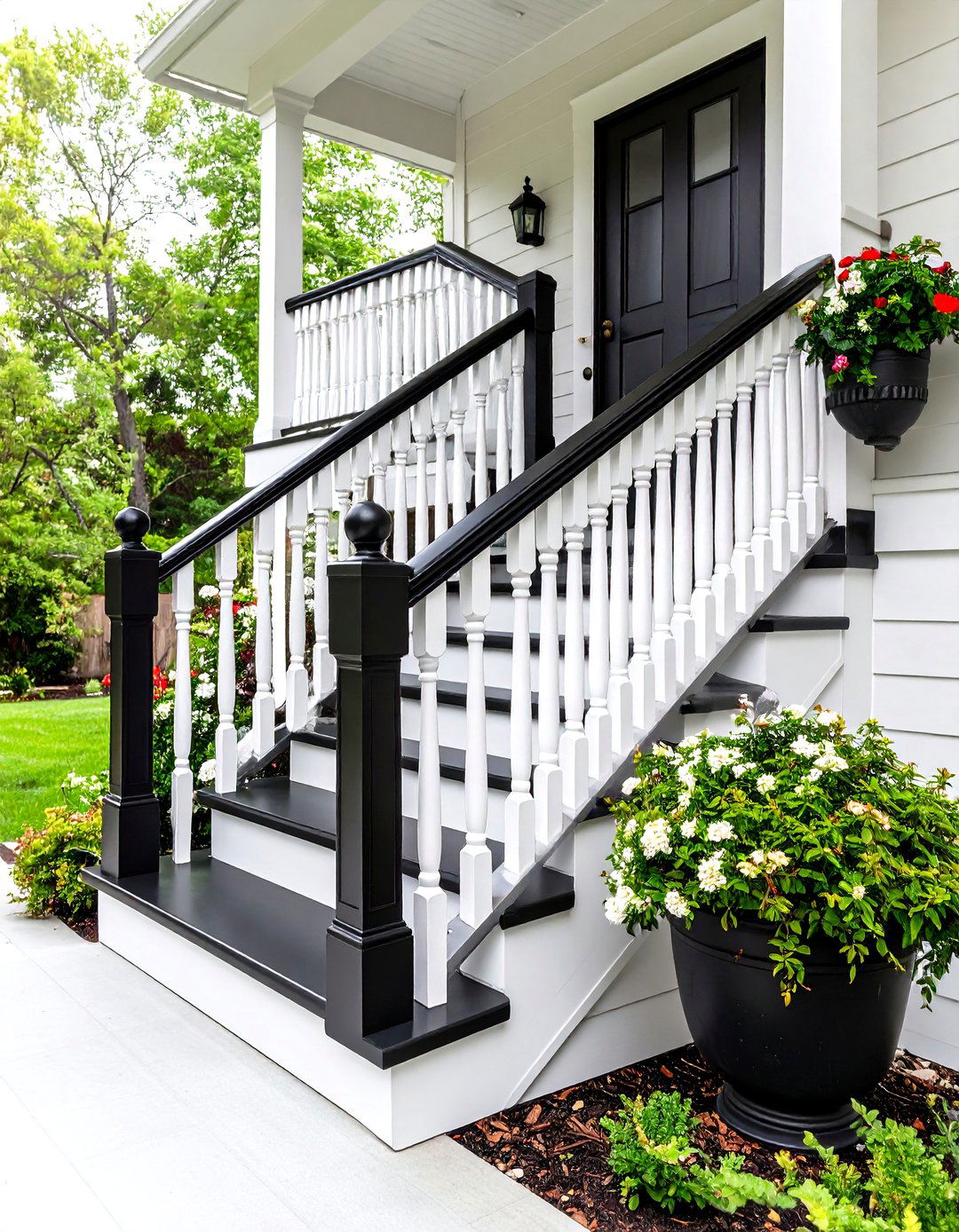
Painting the handrail and newel bases matte black while leaving balusters bright white gives a stair railing graphic punch. The Spruce calls the palette foolproof for modernizing older homes. Houzz commenters liken the combo to eyeliner, defining every architectural line. Scuff-sand, prime, and apply scuff-resistant enamel; finish with black screws so hardware disappears.
25. DIY Maple-Branch Stair Railing
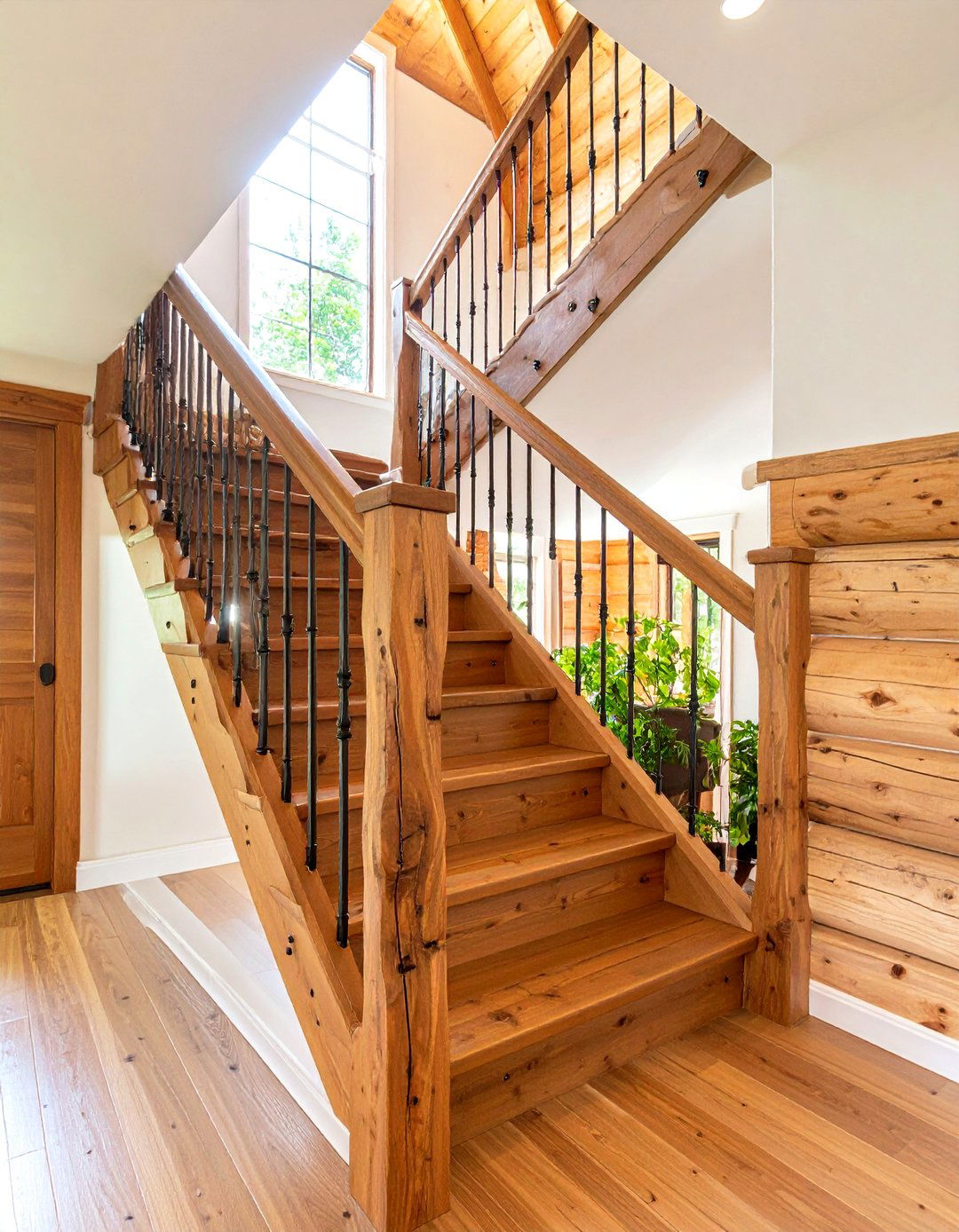
Finally, harvest a sinuous maple sapling, bend it into place while green, and let it dry into an organically curved stair railing. A YouTube builder documents the process in an off-grid cabin. Pinterest twig-railing boards prove willow or apple wood work just as well. Install with adjustable saddle brackets so the branch floats slightly off the wall, allowing seasonal movement without cracks.
Conclusion:
From barnwood-and-iron mashups to rope banisters and live-edge slabs, a farmhouse stair railing can be as humble or high-design as your budget and imagination allow. The common thread is texture — weathered wood, honest metal, and organic shapes that trade perfection for personality. Choose an idea above, respect local codes for height and spacing, and you’ll gain not just a safer staircase but a story-rich centerpiece that greets visitors before any sofa or shiplap wall. With the right railing, every step up feels like a step deeper into home.


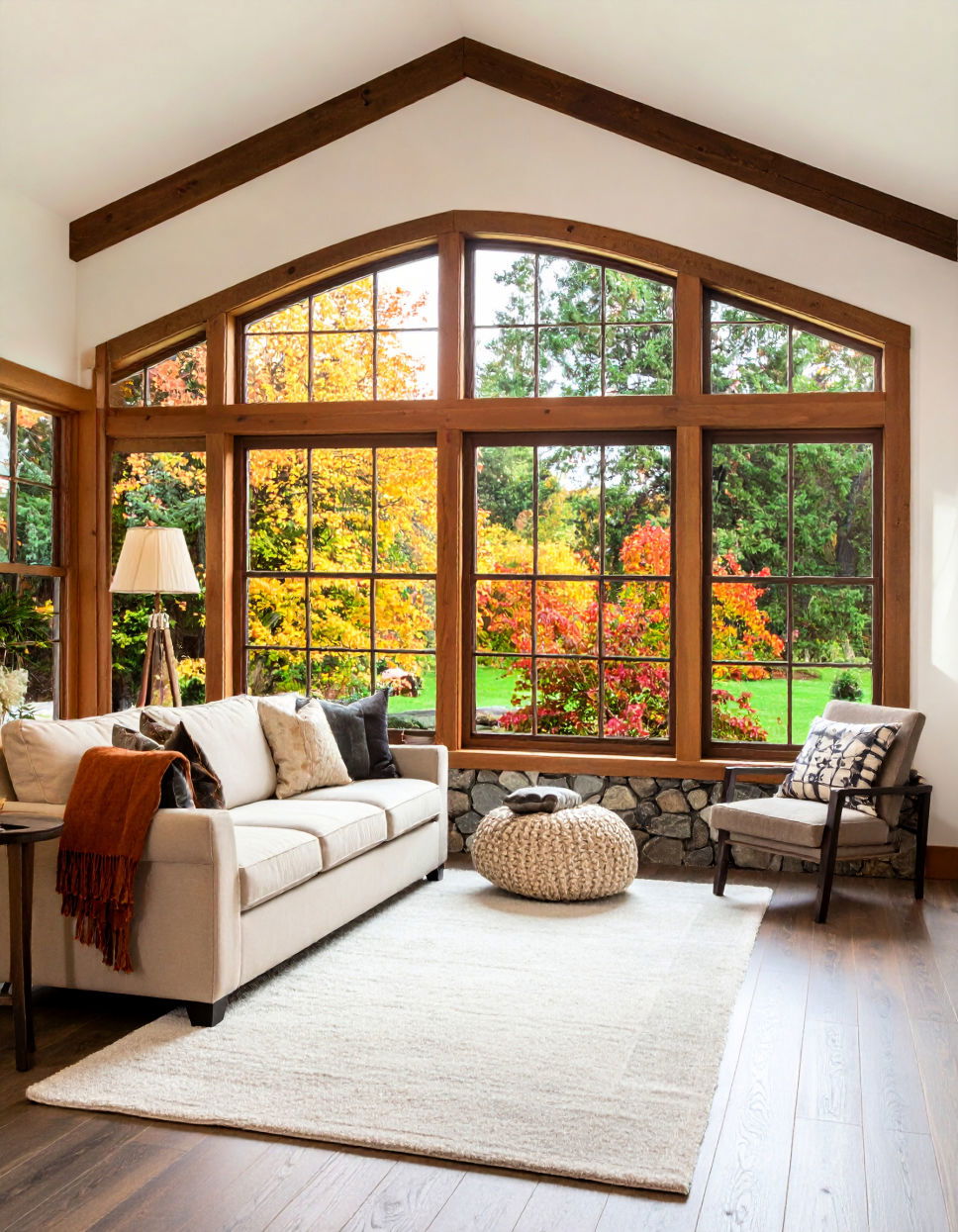
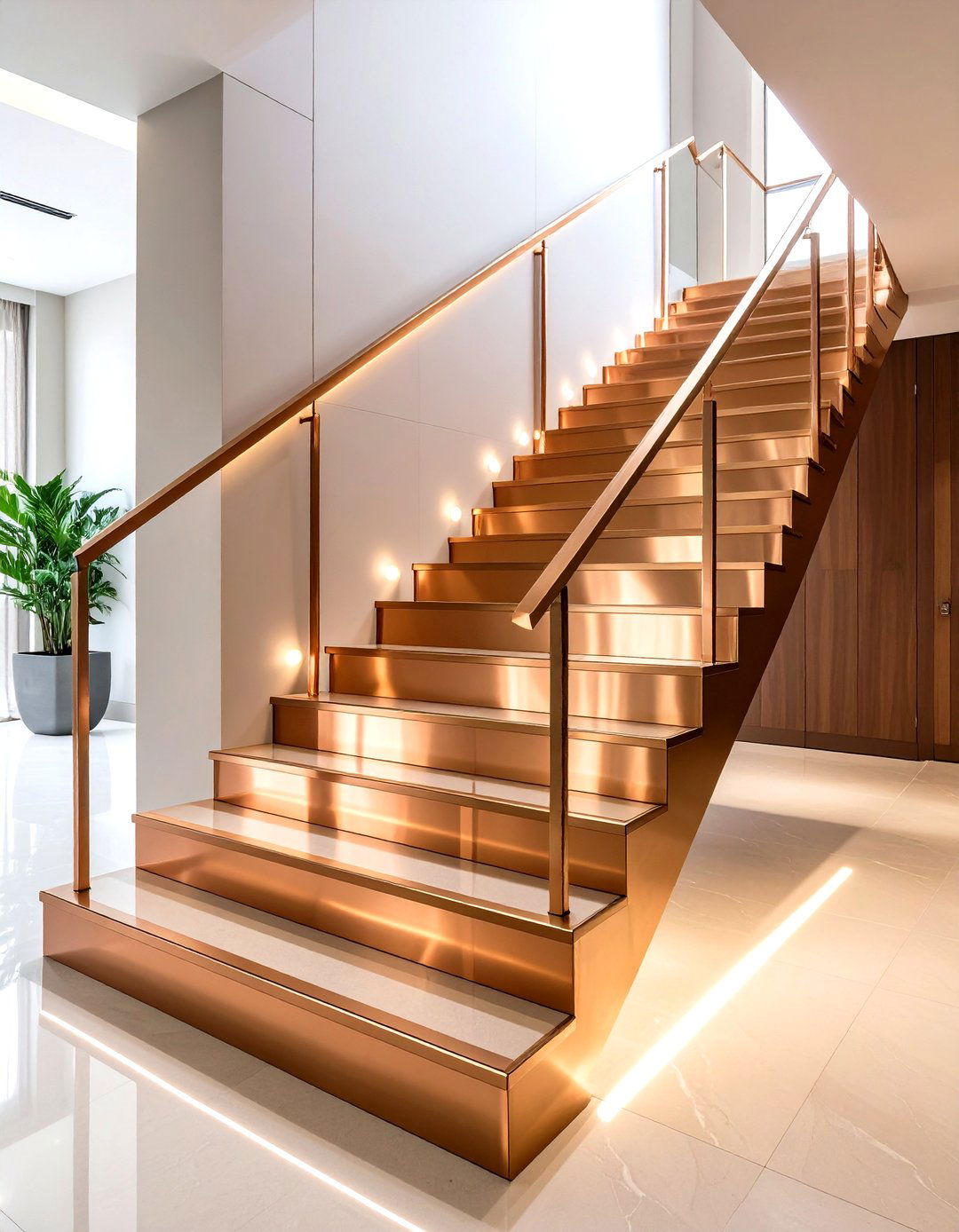
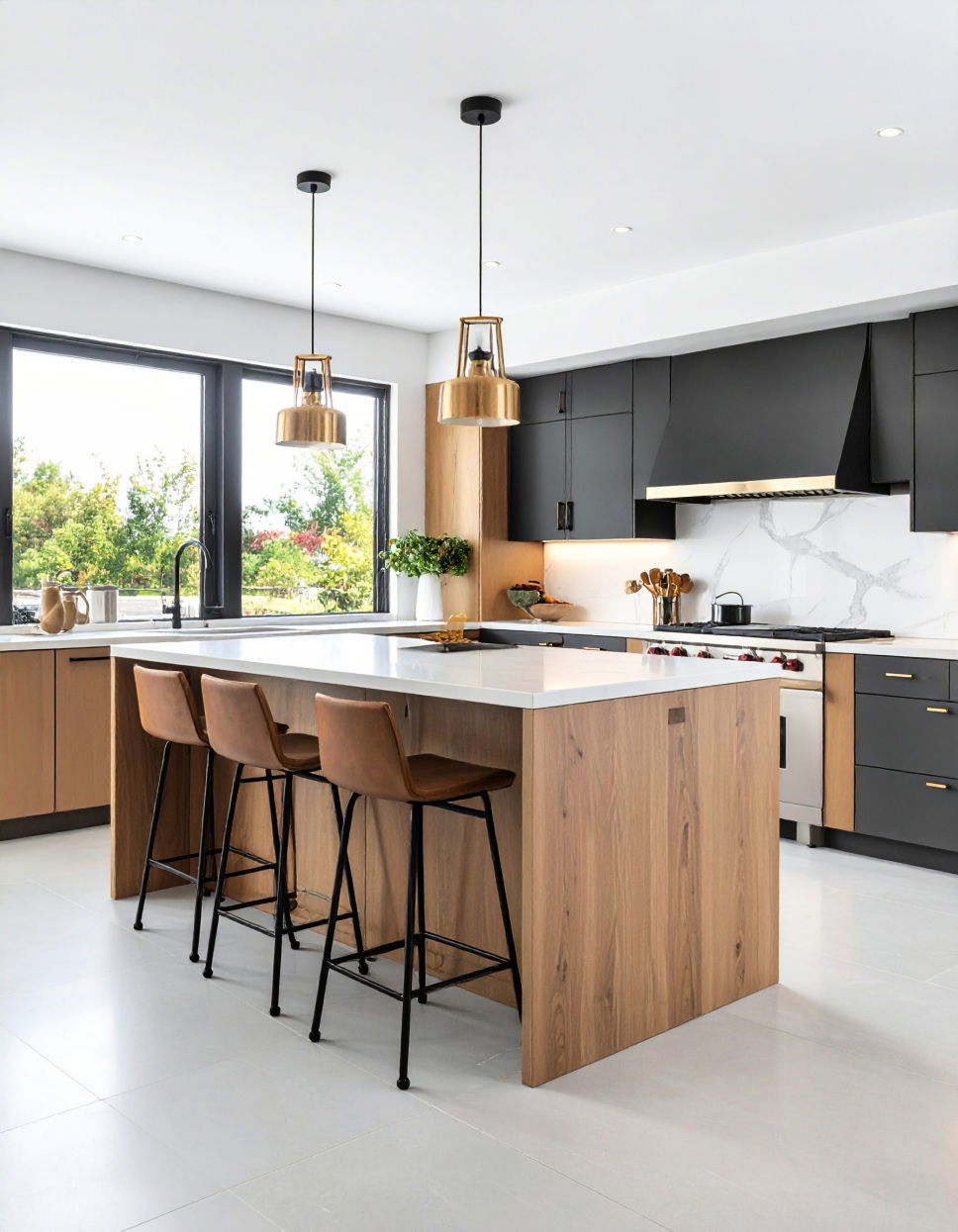
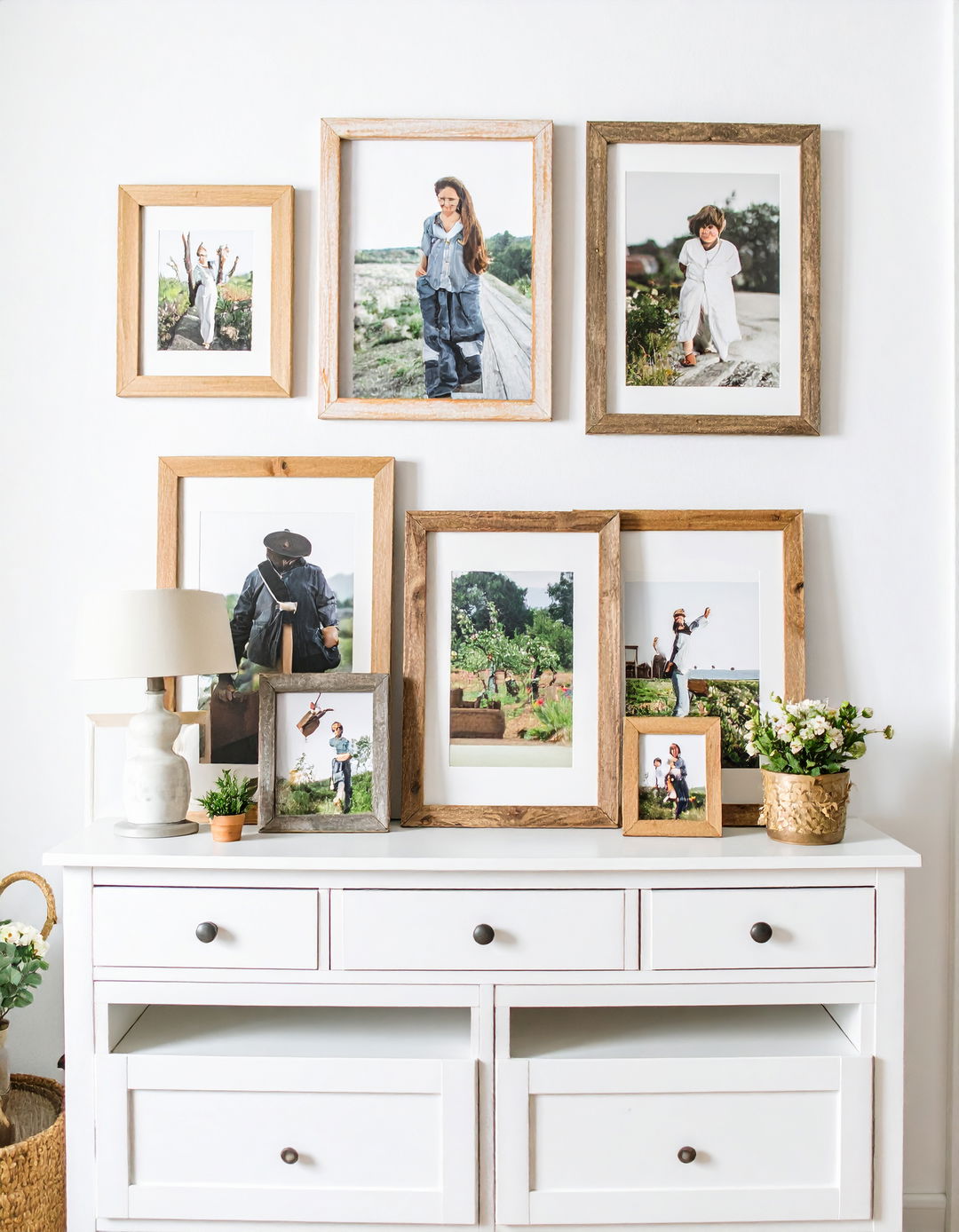
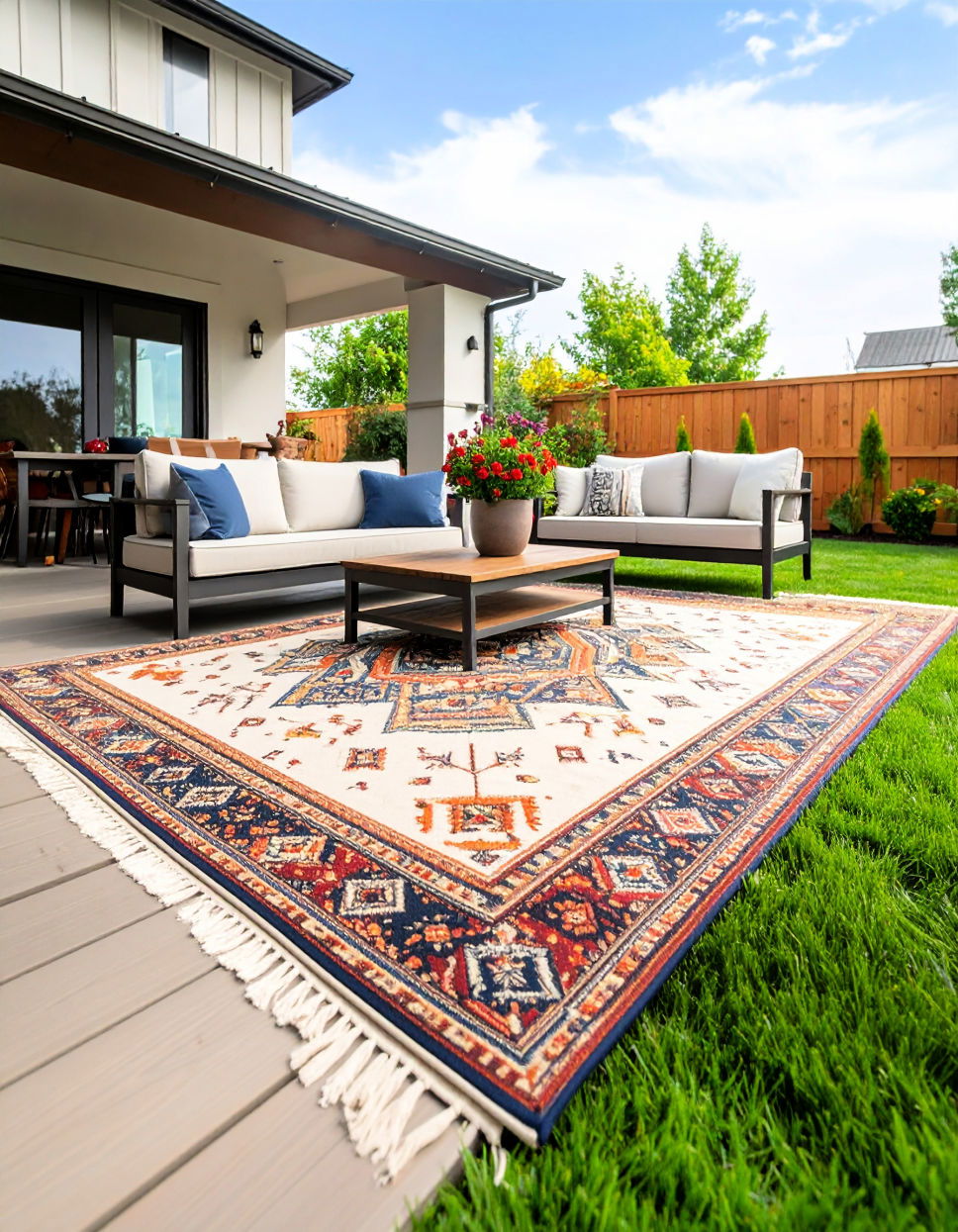
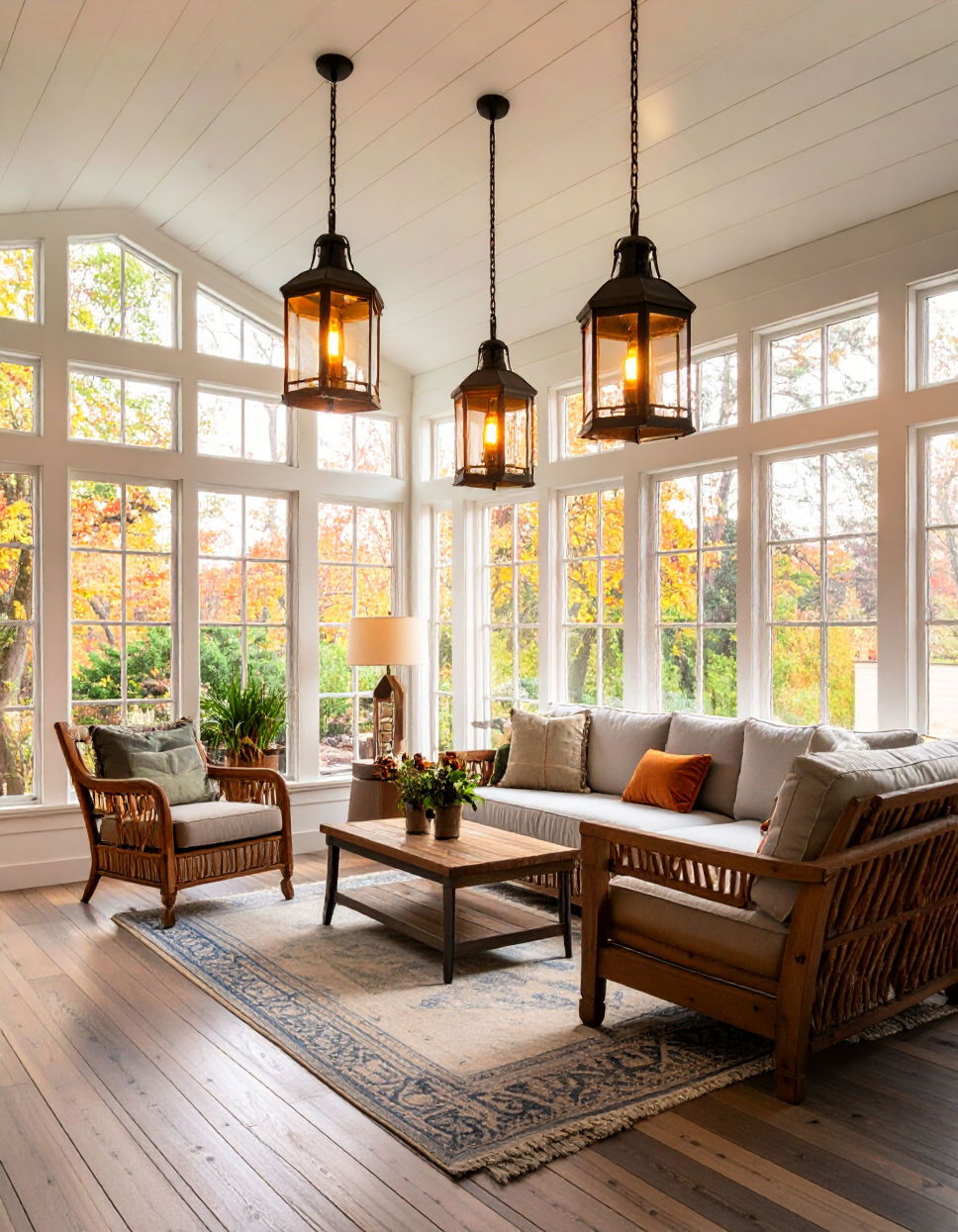
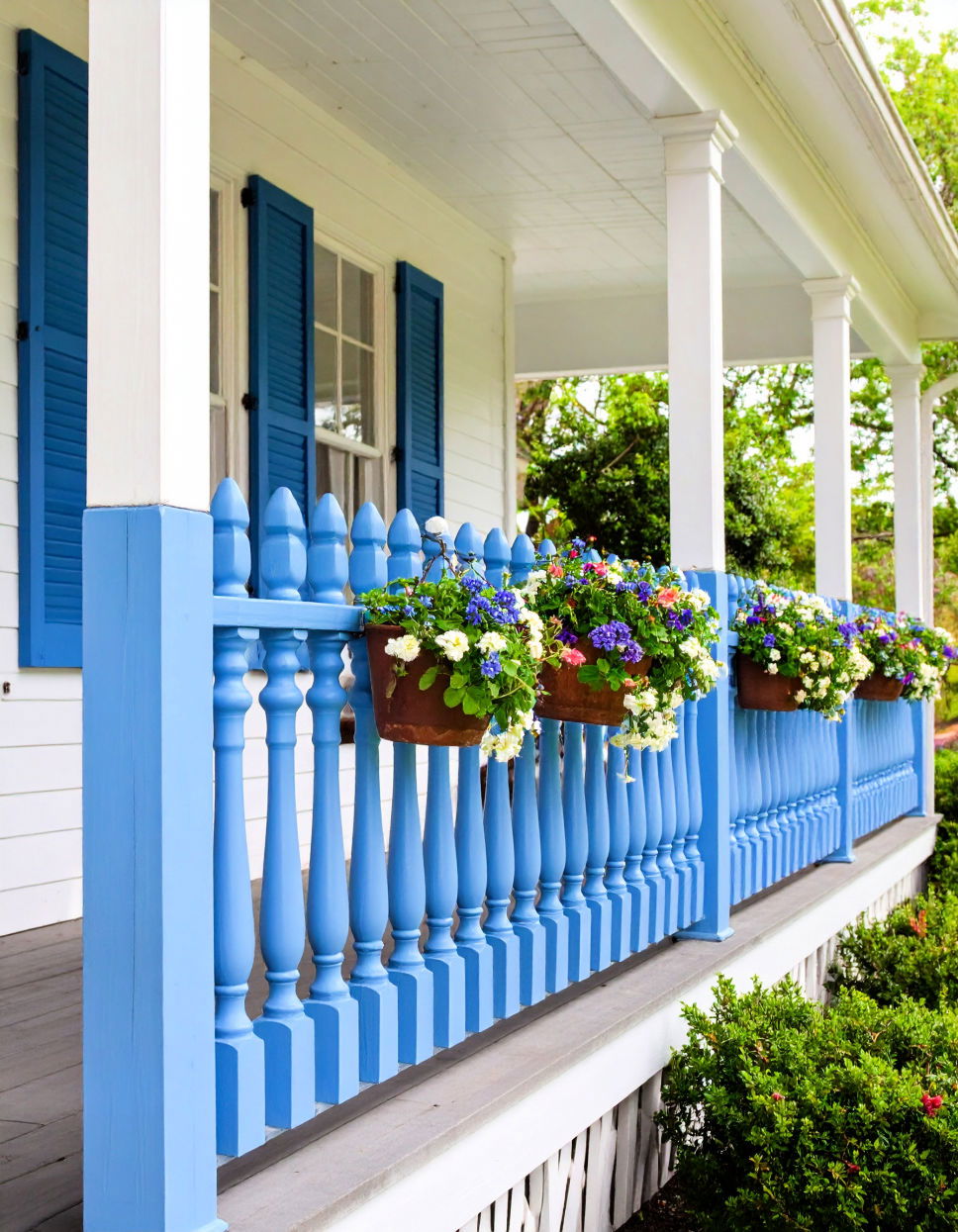
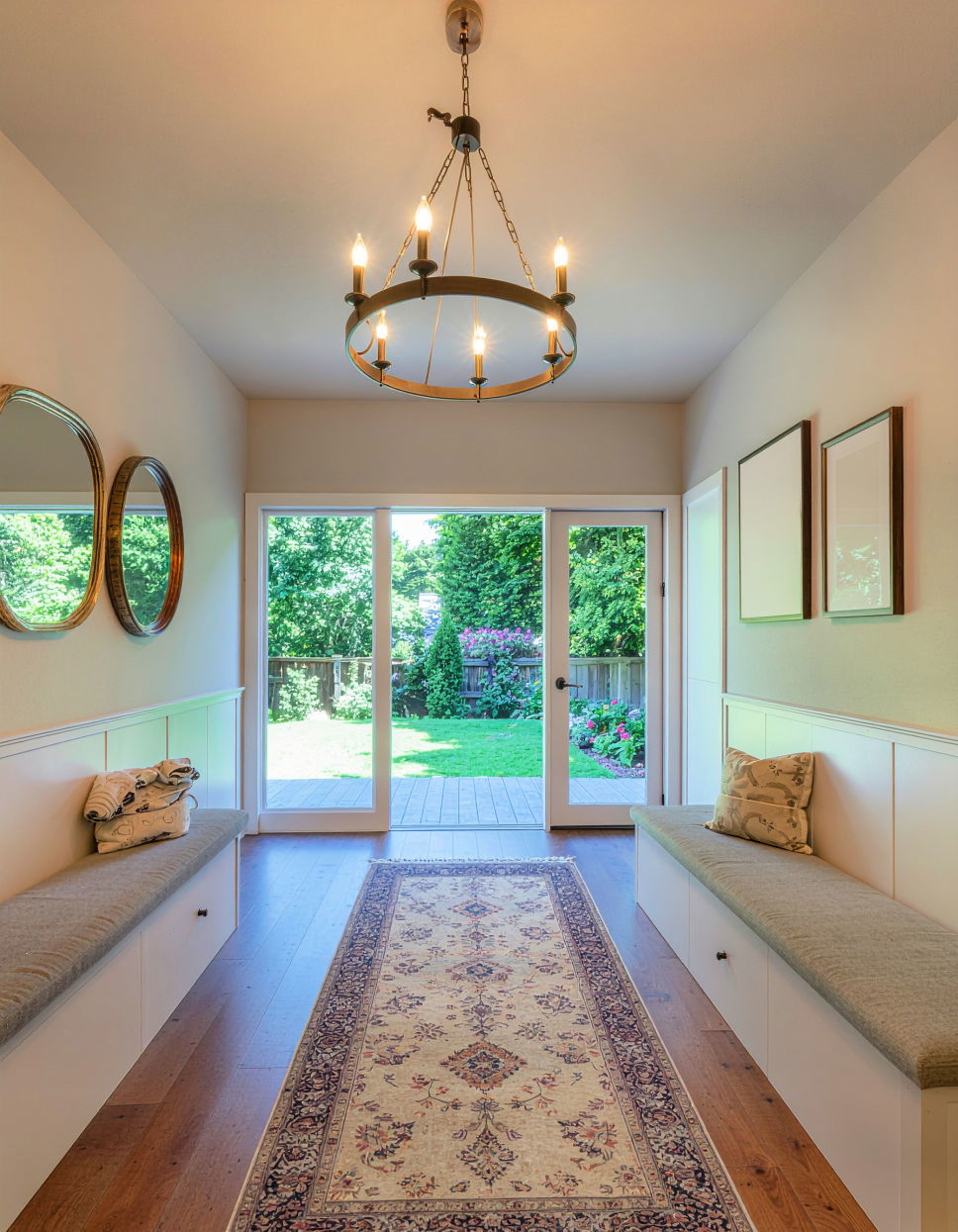
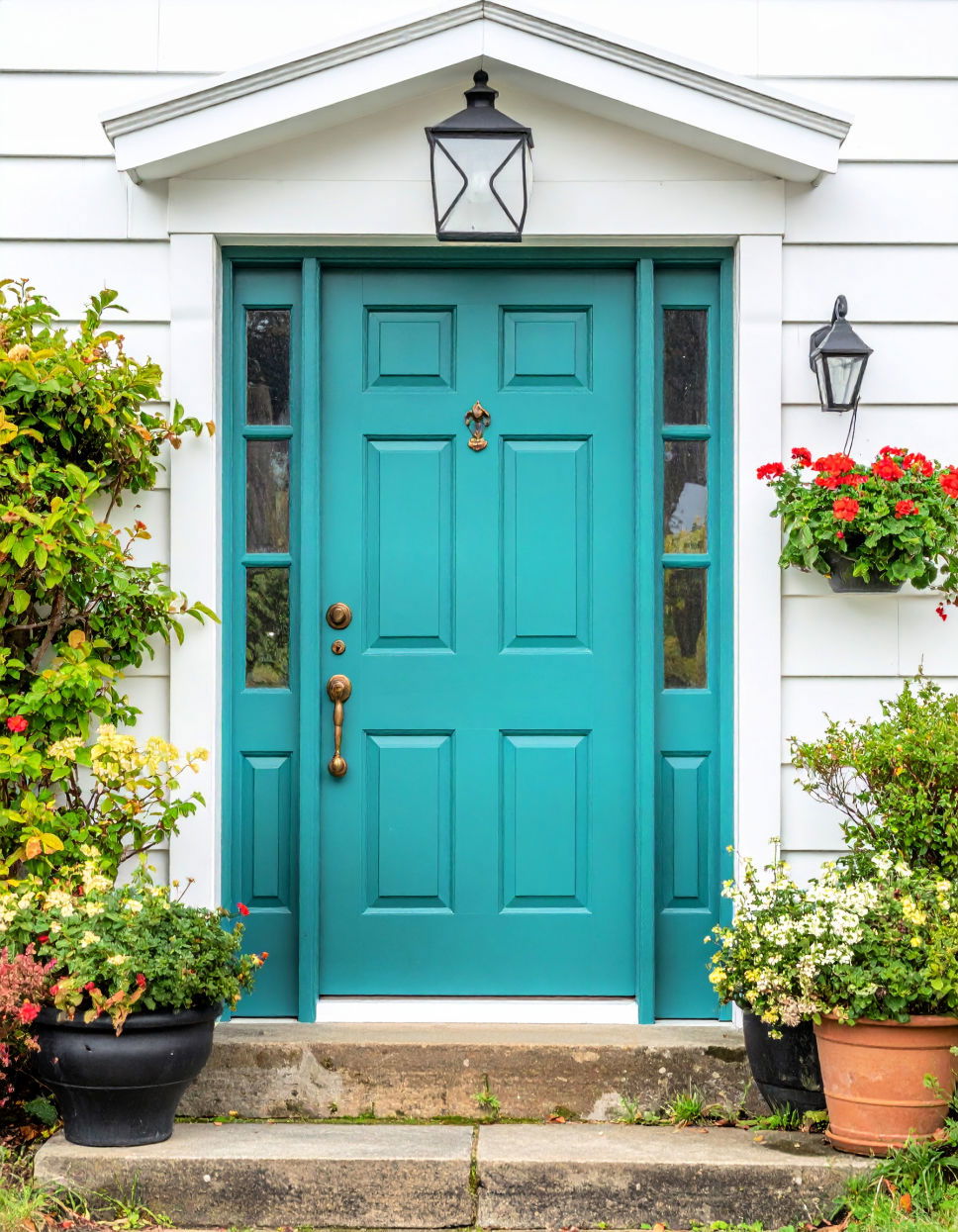
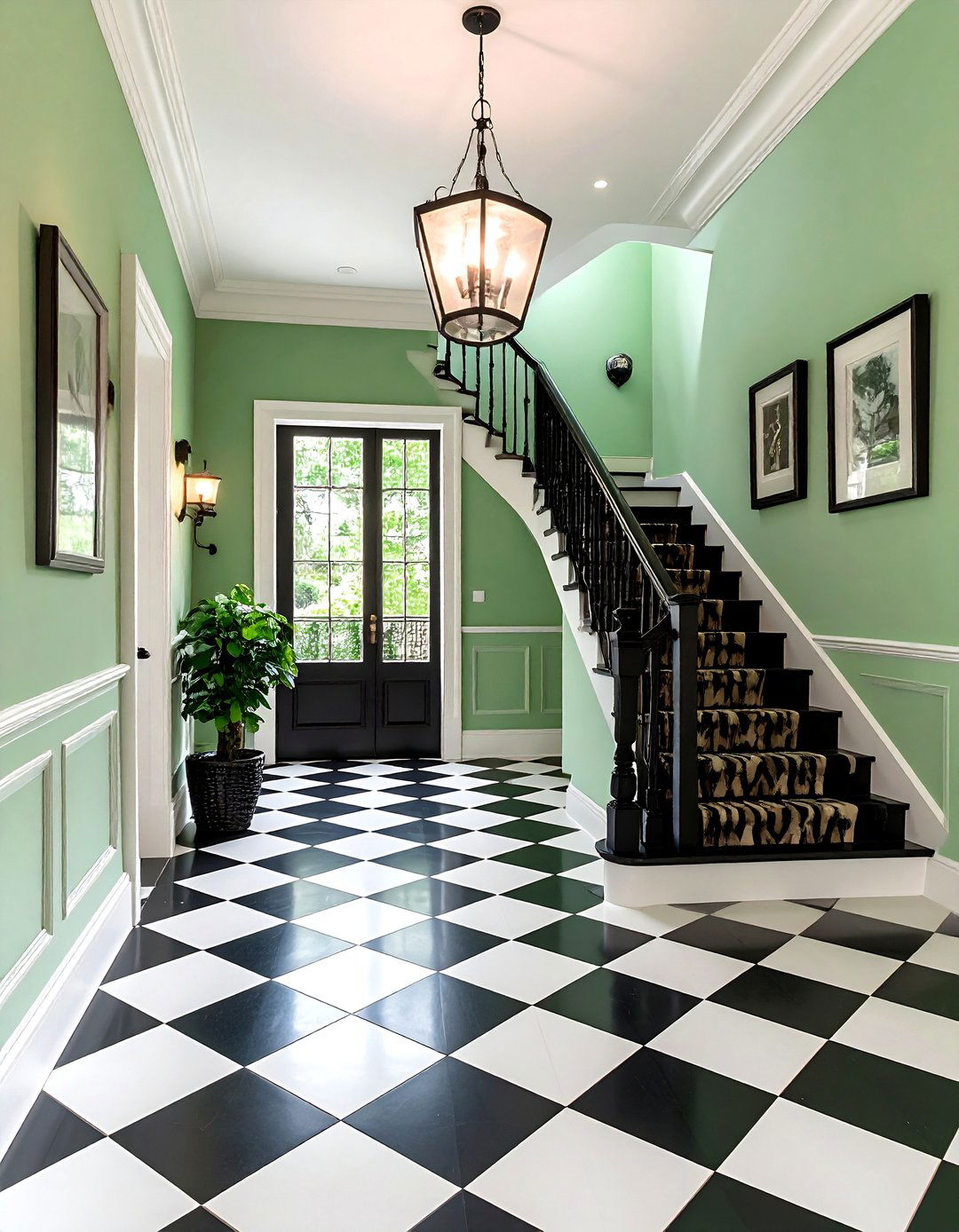
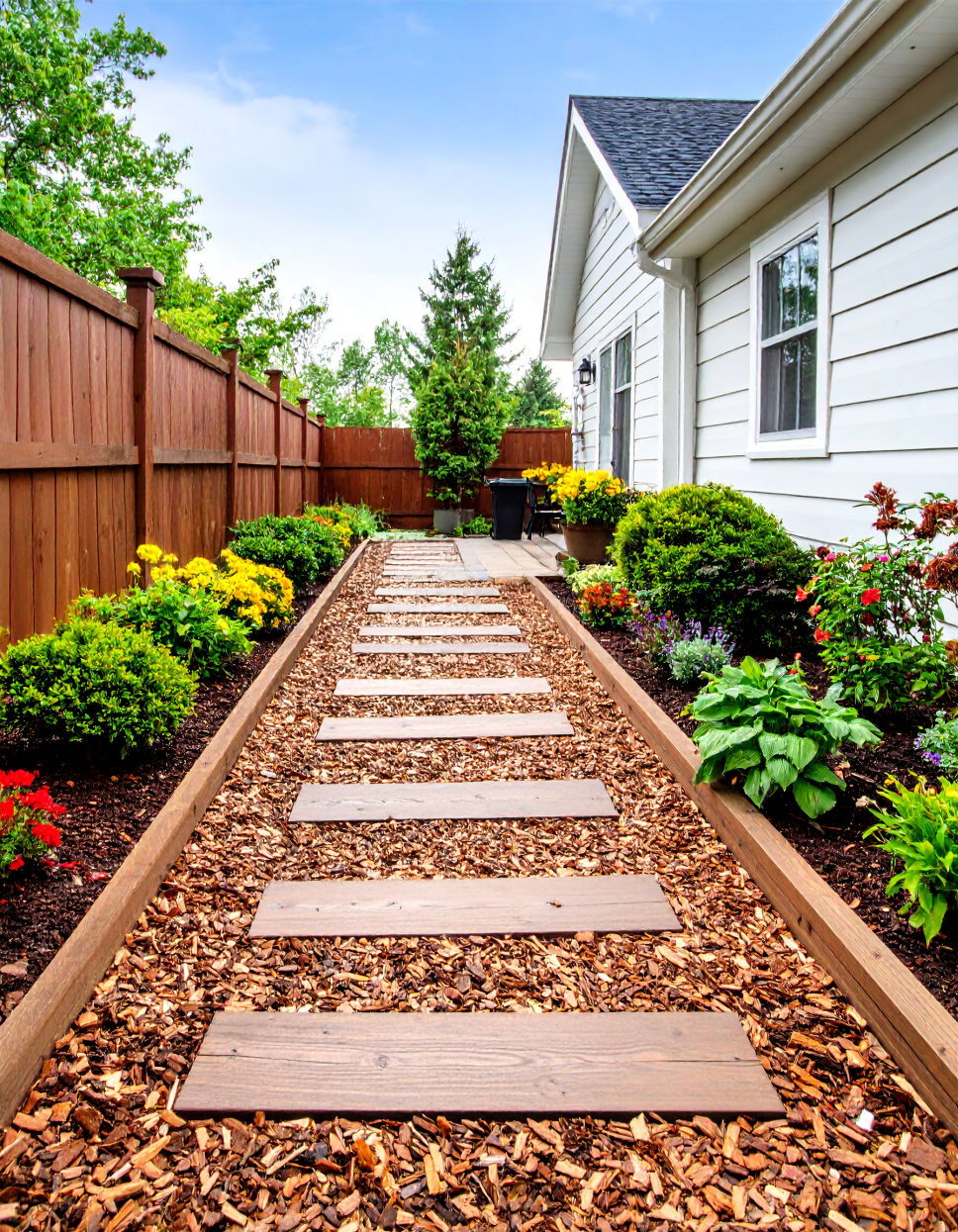
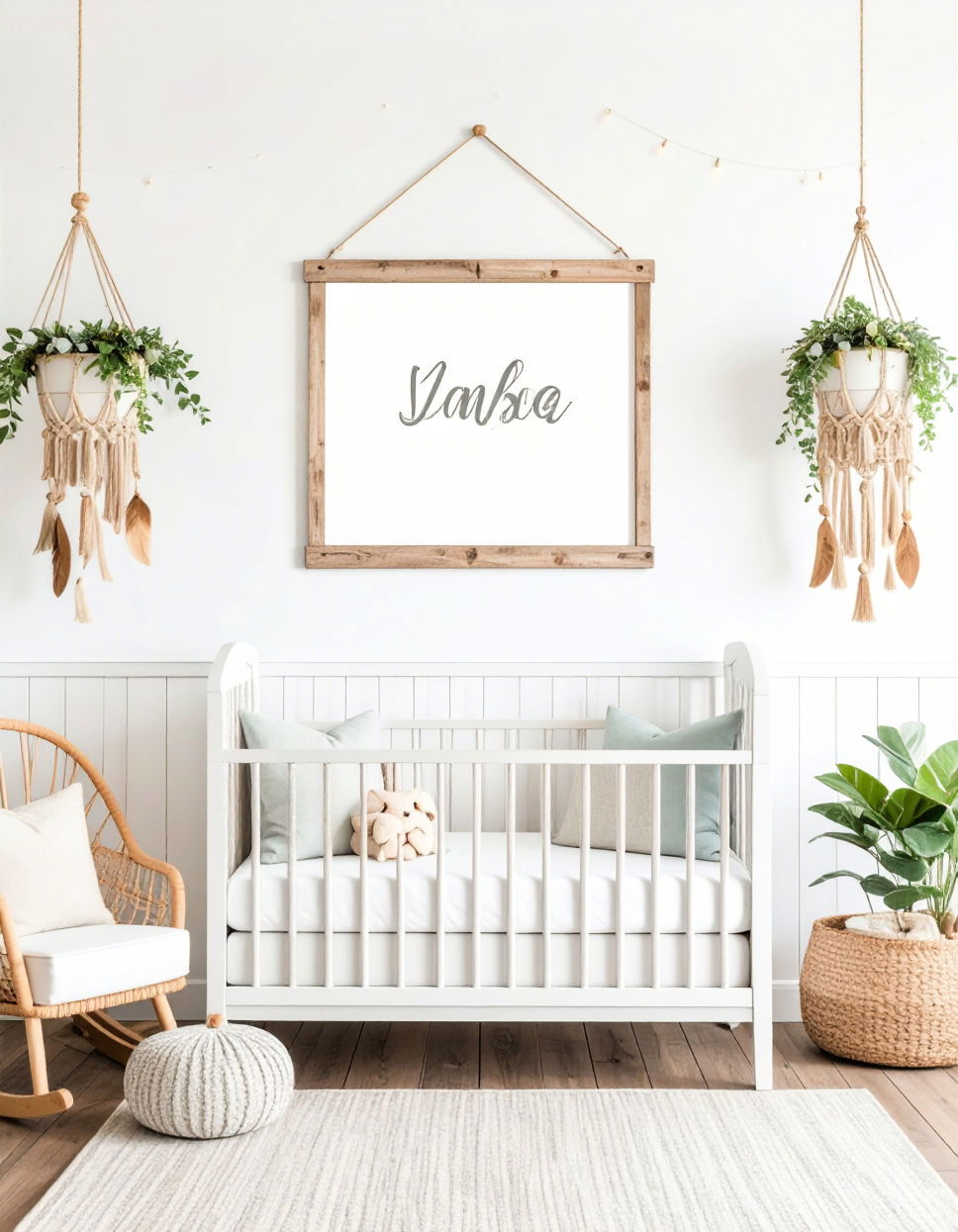


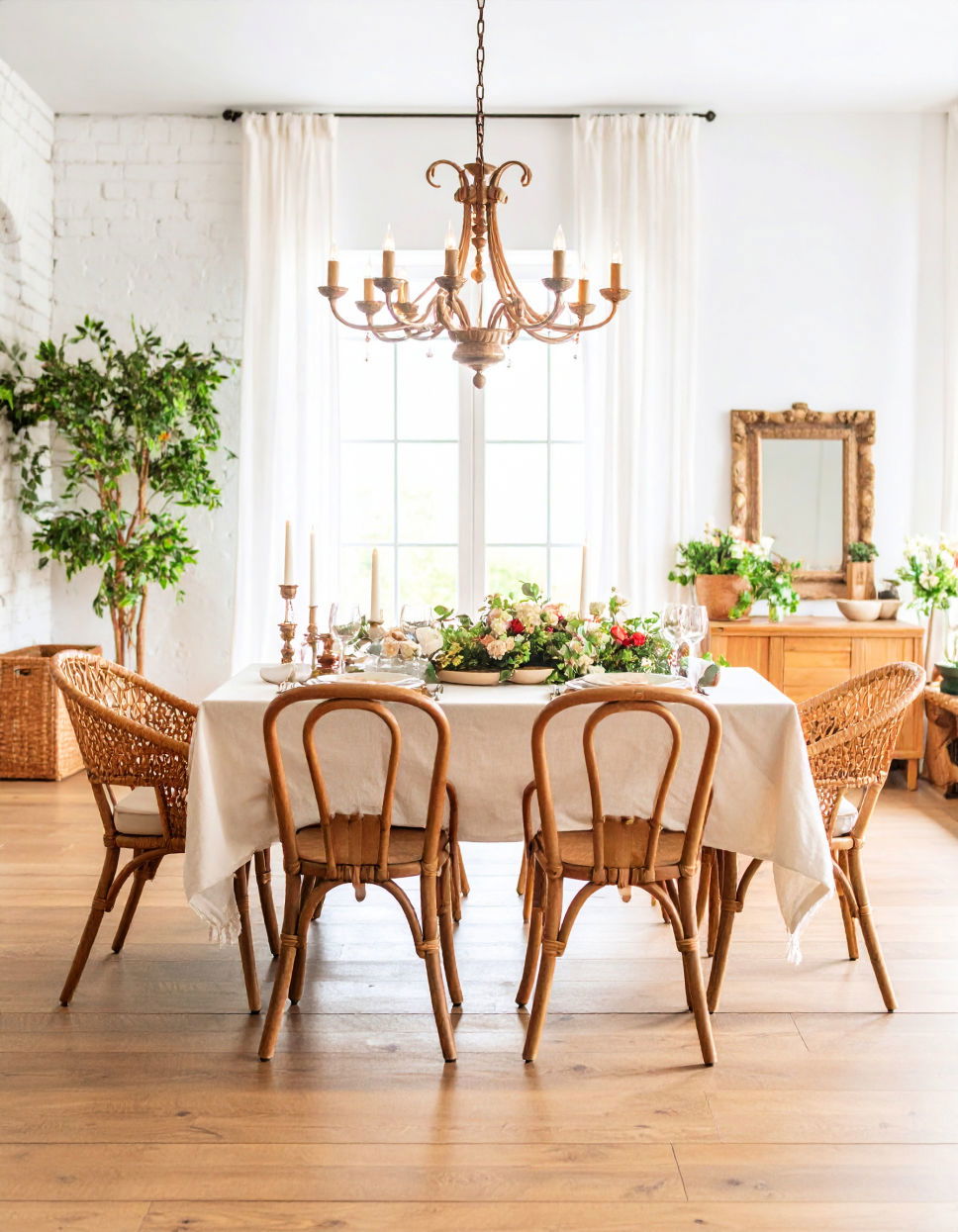
Leave a Reply